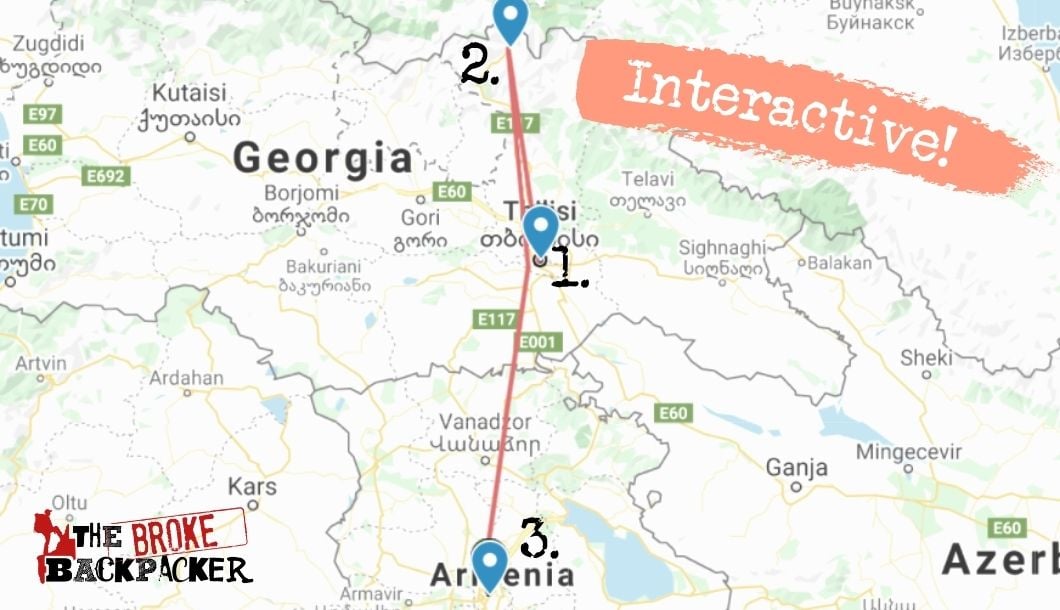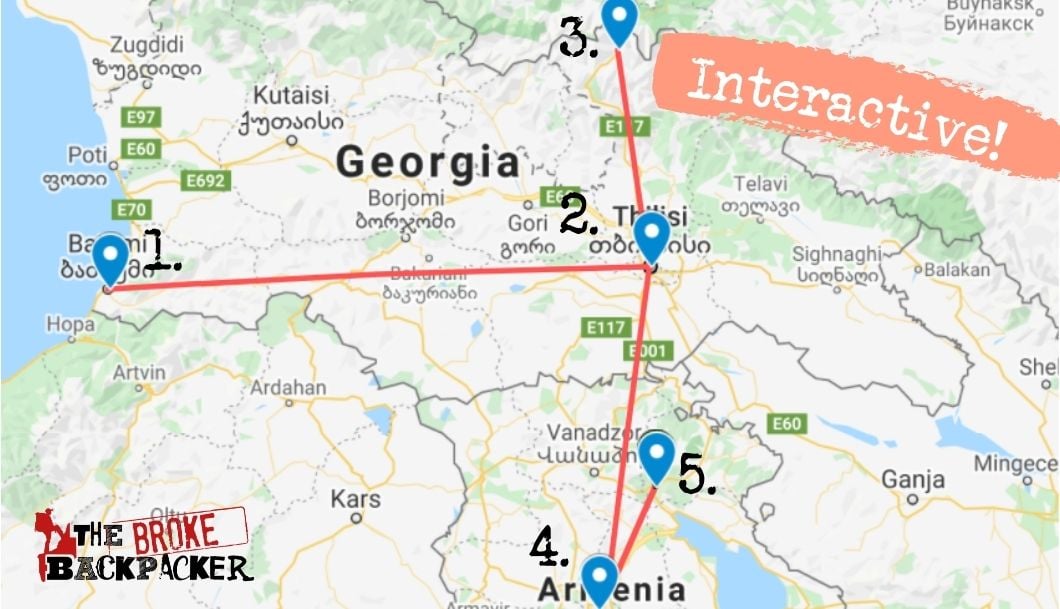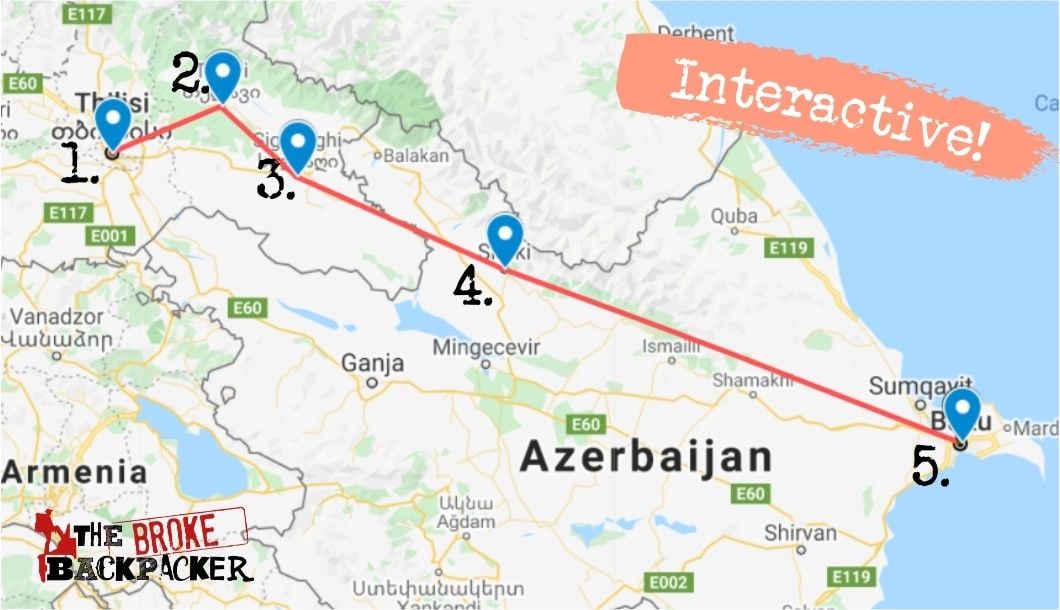Are you craving beauty, adventure, and mindbogglingly delicious food experiences that will knock your socks off to the other side of the stratosphere?
Duh. Of course you are.
I might be setting the expectation high – but I can’t help it. We’re about to enter one of my favourite regions. I’m obviously talking about backpacking Caucasus.
AKA: Georgia, Armenia, and Azerbaijan.
Located between the Black Sea and Caspian Sea, and bordered by such giants as Turkey, Iran, and Russia, no one really knows if Caucasus is really Europe or Asia. All I know is that it is seriously underloved by backpackers and tourists alike for absolutely NO reason.
Sure, you might’ve heard of Georgia, and it is my absolute favourite of the trio. But how about Azerbaijan and Armenia? All three are a fascinating mixture of their Ottoman and Soviet history, and modern-day efforts to become more international amidst all their internal skirmishes.
Buckle up for the ride – we’re about to head to the very east of Europe. Welcome to the comprehensive Caucasus travel guide!
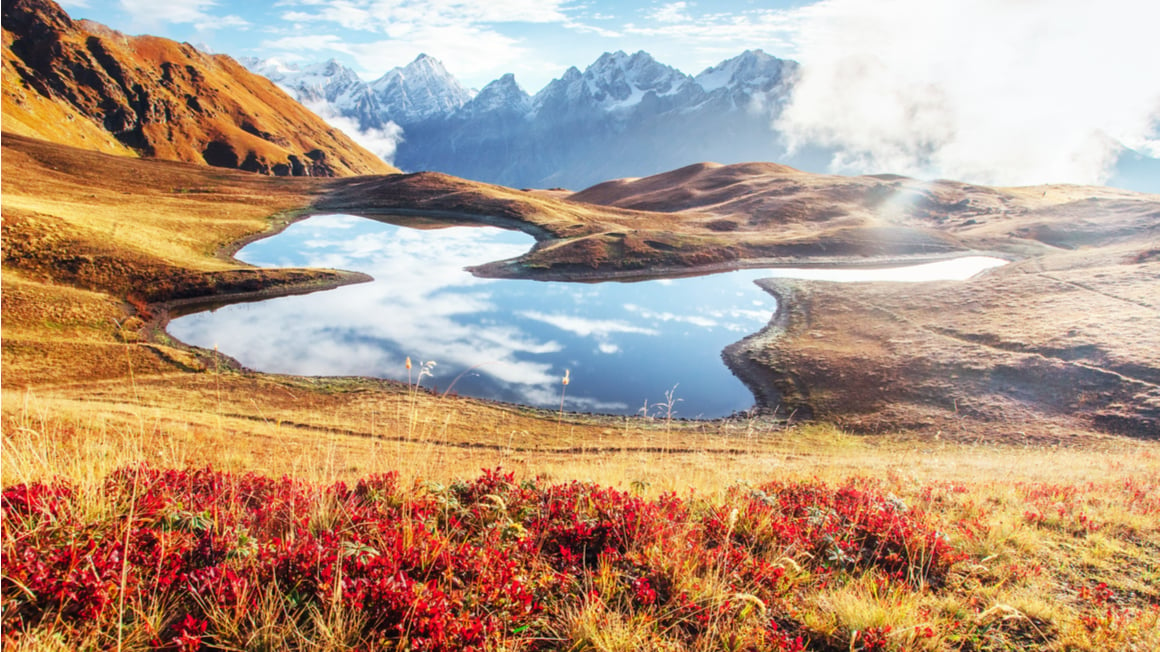
Why Go Backpacking in the Caucasus?
Let me start with one word for y’all: MOUNTAINS. The Caucasus is a hiker’s paradise. The seemingly endless trails were one of the main things that first sucked me in and then kept me there way past my intended itinerary. (I came to Tbilisi for “a few weeks”… and ended up backpacking Caucasus for over three months. Oops.)
But even if you’re not the hiking type, there’s just so much unique, exciting stuff to see that there’s no reason to skip the Caucasus. Especially if you’ve already backpacked through Eastern Europe and seen all the usual suspects and now you’re on the lookout for new thrills.
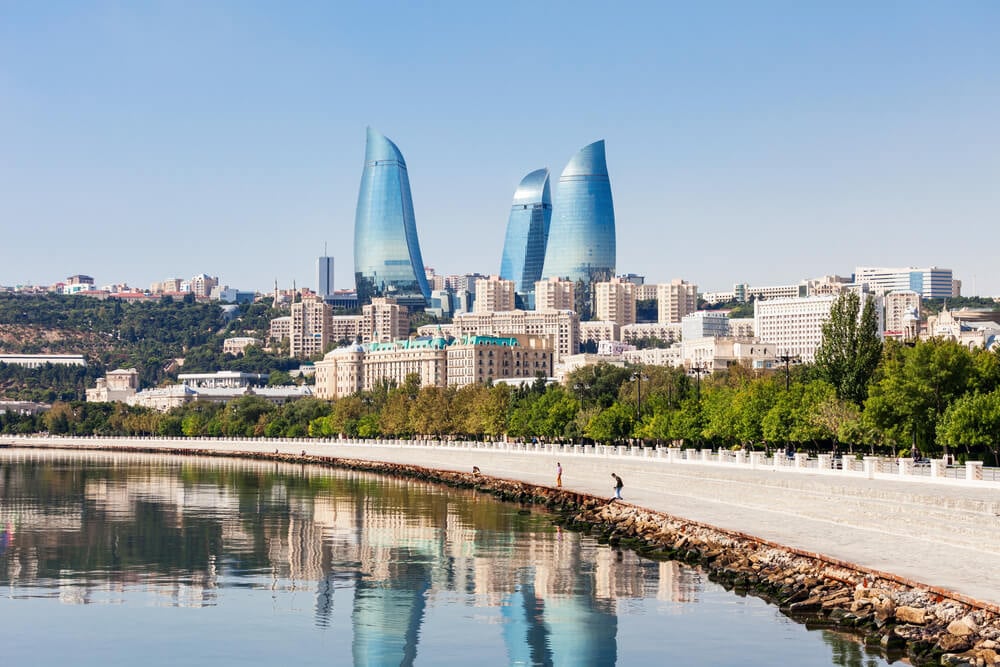
I’m talking postcard cities. Pieces of Soviet history hidden in the nooks and crannies of Ottoman relics and dirt-cheap luxury apartments. There are monasteries like you’ve never seen before. Vines drape your Airbnb front gates and street cats are just waiting to be pet.
The hospitality is iconic. And there’s not a Starbucks in sight!
Ah, and you can’t talk about backpacking Caucasus without mentioning the food. Seriously, just the food and drink would be enough to get me to book tickets back. Food in the Caucasus is heavy, filling and delicious…
Be prepared for an overdose of cheese! Wash it all down with some awesome local wine and you’ll be well fuelled up for all the upcoming adventures.
- Best Travel Itineraries for Backpacking Caucasus
- Best Places to Visit in the Caucasus – Country Breakdown
- Top 10 Things to Do in the Caucasus
- Backpacker Accommodation in the Caucasus
- Caucasus Backpacking Costs
- Best Time to Visit Caucasus
- Staying Safe in the Caucasus
- How to Get Into Caucasus
- How to Get Around Caucasus
- Working and Volunteering in the Caucasus
- Culture in the Caucasus
- Final Advice Before Visiting Caucasus
Best Travel Itineraries for Backpacking Caucasus
So, travel in the Caucasus is not as straight-forward as it looks on the map. But, it’s not overly hard either. It just requires you to plan your trip a lil’ bit.
If you’re on limited time and really, really need to skip something, skip Azerbaijan. There are not so many attractions in Azerbaijan, and since it requires a visa, visiting Azerbaijan needs an extra step compared to the two others.
If you’re REALLY on limited time and only have time to visit one country in the Caucasus, visit Georgia.
Here are some ideas for your Caucasus travel itinerary!
1-Week Itinerary for the Caucasus: Georgia and Yerevan
In a week, you can see the most popular sites that are, luckily, very well connected!
Start in Tbilisi, the capital of Georgia. You can spend the first few days exploring the Old Town, drinking wine, and hanging out at cute riverside bars.
Next up: mountain action. Take a minibus to Stepanakert, the main town in the mountain region of Kazbegi. Since the trip from Tbilisi only takes about three hours, it’s a popular weekend destination and by far the most accessible mountain region from Tbilisi. It’s also home to the Gergeti Trinity church; potentially the most famous sight in the ENTIRE country.
Return to Tbilisi to catch an overnight train. We’re headed to Yerevan, the capital of Armenia, on a whirlwind two-day trip. Make sure to book a tour or a driver so that you can take in as much of the dazzling capital and its surroundings as possible!
2-Weeks Itinerary for the Caucasus #1: Georgia and Armenia
Start the trip in Batumi by the Black Sea. By day, tan on the beautiful black sand beaches. By night, hit up the party scene!
After Batumi, take a train to Tbilisi to spend a few days there (and try not to fall in love with all of its awesomeness, we’re on a bit of a time crunch here).
From Tbilisi, travel up north to Kazbegi. You can stay at the town of Stepantsminda and check out some of the hikes closest to the town.
From Kazbegi, return to Tbilisi to catch your train/bus/flying carpet to Yerevan, the capital of Armenia. Time-wise, you get the most time at the destination if you take the night train.
What to do in Armenia, then? Yerevan has plenty to do for two or three days, especially if you expand your explorer’s gaze to nearby sites like Khor Virap monastery and Garni town.
The next stop: Dilijan National Park. (This happens to be my favourite part of Armenia!) It’s easy to explore from the main town Dilijan, and there are trails and small museums to keep you entertained for a few days.
After this, you can grab a minibus back to Yerevan or hitchhike to Tbilisi/get a taxi to Vanadzor and a train from there to Tbilisi.
2-Weeks Itinerary for the Caucasus #2: Georgia and Azerbaijan
Time to take the road less travelled…
Start your expedition in the awesome Tbilisi. I could spend WEEKS there but for the sake of this itinerary, let’s say you’ll spend three days exploring the best things to do in Tbilisi: the Old Town, monasteries, wine bars, and baths.
You COULD spend the next couple of days up in Kazbegi, but let’s mix it up a bit. From Tbilisi, we’ll be heading east towards Kakheti – Georgia’s best wine region.
Your first stop should be Telavi. It’s a small town but rich with awesome street art and some of the best examples of the iconic Georgian “wooden lace” terraces, and you can easily visit a famous house museum in the nearby town Tsindali.
After that, check out Sighnaghi. Many people visit this tiny town as a day trip but it’s hands down the most romantic place in Georgia, and definitely worth an overnight stay!
Then, Azerbaijan. There are no direct buses from Telavi or Sighnaghi to Sheki, our next stop. But a combo of bus-taxi-walk over border-taxi-bus works well enough. Lifehack: I hitchhiked.
Spend a couple of days exploring Sheki before catching the night train to Baku (to save time – the Azeri capital is all the way on the other side of the country). Baku Old Town and the surrounding attractions easily keep you entertained for a couple of days.
3-Week Itinerary for the Caucasus: The Whole-y Trinity
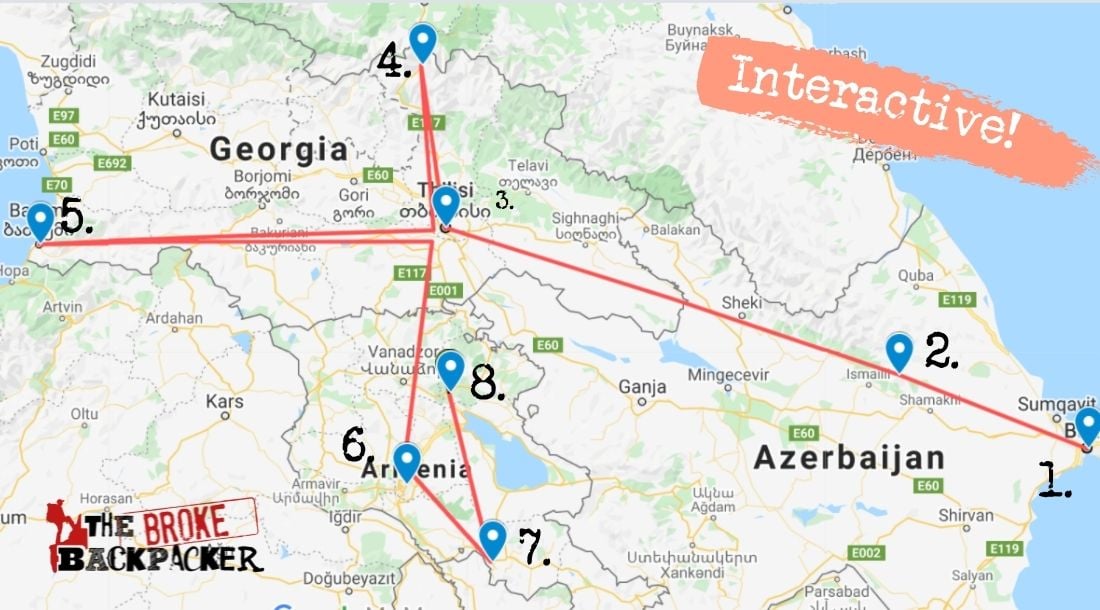
Start in Baku, Azerbaijan. We’ll spend the first few days here checking out the old town and the surrounding sights (believe me, there are many!). I’d also recommend taking a day trip to one of the mountain towns to check out the traditional ways of life – my fav is Lahic.
Take an overnight train from Baku to Tbilisi. (You’ll miss a lot on the way but it’s the easiest and fastest way between the two countries.)
Tbilisi will be your base for the next destinations – sorry to make you jump back and forth! First, head up to the mountains in Kazbegi for a couple of days, then come back through Tbilisi to connect to a train to Batumi by the Black Sea. Aaand then back to Tbilisi again.
From Tbilisi, it’s very easy to travel to Armenia. Spend some days in Yerevan before heading for an overnight trip to Areni, the heart of winelands in Armenia. Then, make your way back to the capital.
Yerevan is your connecting point to get to the Dilijan National Park. You can spend a few more days hiking before heading back to Yerevan or Tbilisi, depending on where your next destination is.
1-2 Months Backpacking the Caucasus: The Best of, in Peace
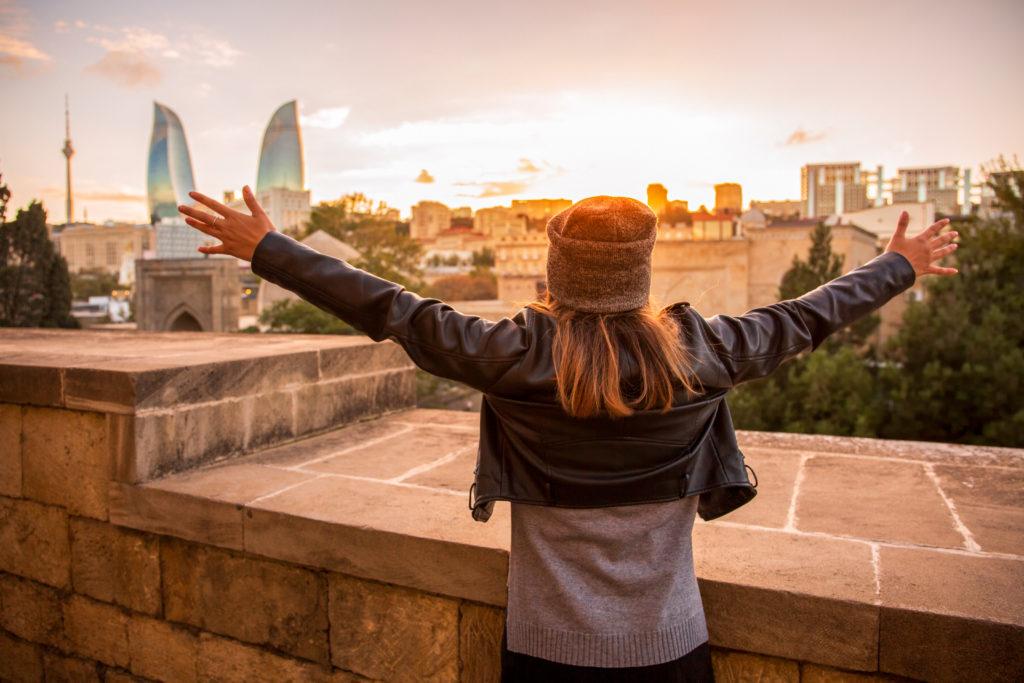
Honestly? If I could, I would just get to Tbilisi with a one-way ticket and take it from there.
I love the Caucasus and I think my over-stay is a pretty good testament to that. You will probably fall in love with the region as much as I did, and then you’ll be sad when you eventually need to leave.
Again, I would reserve the most exploration time for Georgia – a month, at least. In Azerbaijan, I spent about a week, which seemed fair enough, and in Armenia, a little over 2 weeks.
You could start in Azerbaijan and visit Baku, Quba, and Ganja. From Ganja, you can catch a direct bus to Tbilisi in about 4 hours.
In Georgia, you’ll then have time to visit all the usual spots – Tbilisi, Kazbegi, and the Black Sea – but with a flexible schedule. There are ways you can add a few more pearls to your Georgia itinerary:
- Hike in Svaneti, the most beautiful wilderness area in Georgia
- Sip wine and romance yourself in Sighnaghi
- Relax in Borjomi
- Explore all the unique monasteries of Georgia like David Gareja, Vardzia, and the Katshki Column
- Learn about Joseph Stalin in his birth town, Gori
After you’re sick of Georgia (spoiler alert: impossible, but all good things must come to an end), head down to Yerevan, the gateway to all the awesomeness that the severely underrated Armenia holds. Visit Lake Sevan and Dilijan, then travel south to Areni, Tatev, and Goris.
Best Places to Visit in the Caucasus – Country Breakdown
While backpacking Caucasus, you’ll go through very different regions. Each of the three has its own quirks and oddities.
Backpacking Georgia
Backpacking Georgia is usually the main reason travellers gather down to the Caucasus, and for a good reason: it’s teeming with culture, delicious food, absolutely bonkers-beautiful mountainscapes, and relaxing beaches.
But I might be biased. After all, it is one of my favourite countries ever…
Tbilisi is one of the prettiest cities in Europe and the best place in Georgia – and I’m willing to fight you on this. Don’t skip the hot springs – the city gets its name from them! The best Tbilisi travel guides will also recommend checking out the ruins of the Narikala Fortress above the city.
And as good as Georgian wine is, the capital also has some incredible cafés for the daytime, and riverside dive bars and excellent craft beer pubs for after hours. I could spend WEEKS in this lovely, lovely city.
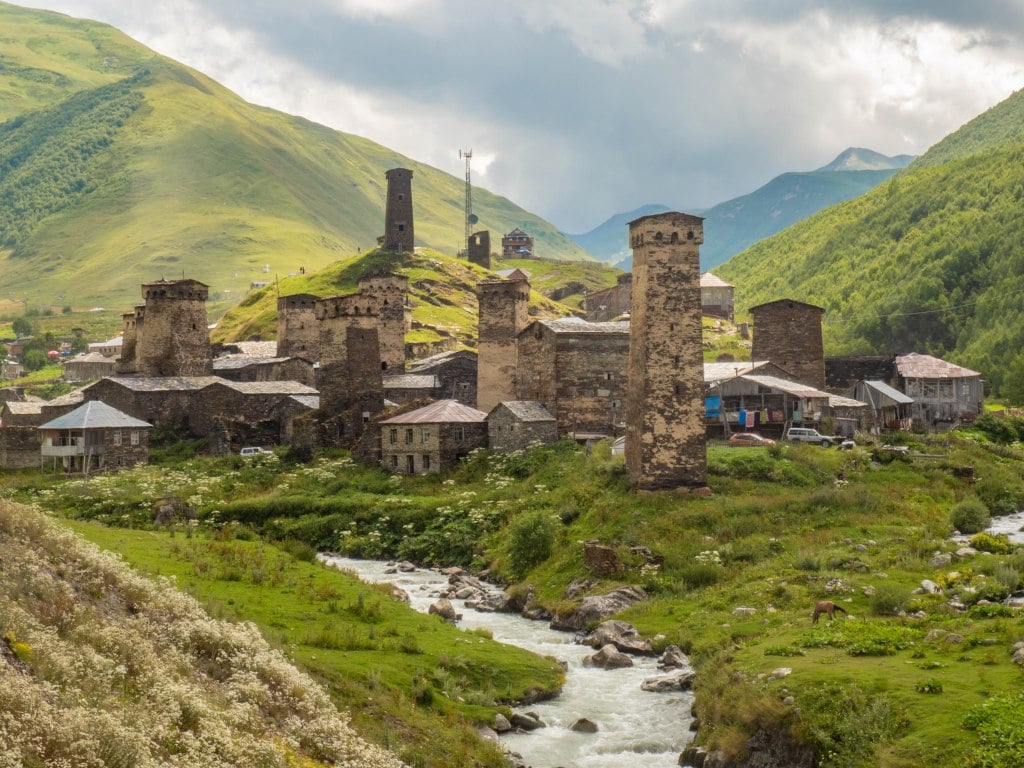
Photo: @wayfarover
This lil’ Georgia travel guide wouldn’t be complete if I didn’t hype the hiking. Trekking is 100% one of the top things to do in Georgia. The best hiking areas for casual hikers are Kazbegi and Svaneti since both have easy and moderate trails.
For real outdoor addicts, I highly recommend also checking out Tusheti and Racha. It’s also worth visiting Borjomi in the south. It has a dozen different trails but many travellers go there just to chillax in nature for a few days.
Craving beach time? Head down to Batumi by the Black Sea. Batumi is known for its strange architecture and statues as well as great nightlife, and it’s a good base to explore the little beach town by the coast.
The east of Georgia is its best wine region. In Kakheti, visit the town of Telavi and Sighnaghi for some history, romance, AND excellent wine.
What to Know Before Visiting Georgia
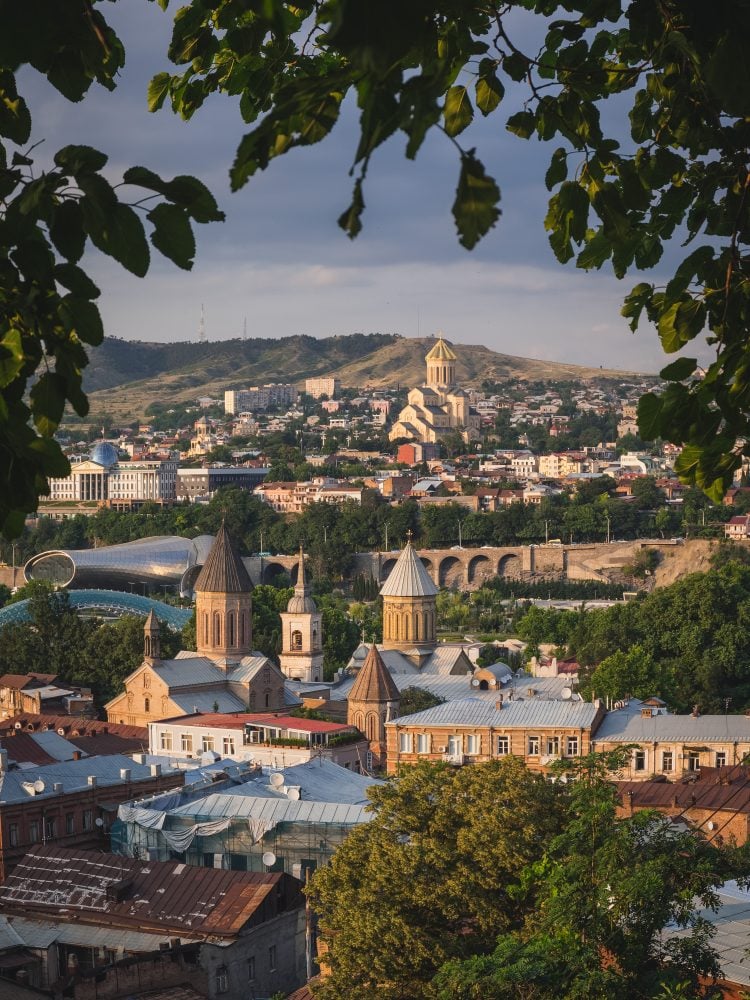
Photo: Roaming Ralph
- Don’t miss out on… The mountains. Even if you’re not the outdoorsy type, hiking in Kazbegi is unmissable.
- You know what’s overrated… Kutaisi. For some reason, Georgia’s second city is constantly on itineraries, despite being very boring and having underwhelming attractions. Skip!
- The coolest hostel is… Fabrika! Delicious food, awesome common spaces to meet other travellers, and events like sunset yoga and rooftop movie nights.
- The best food is found in… Restaurant Barbarestan. It’s expensive and fancy – a rarity in Georgia – but one of the only places in Tbilisi to try local fine dining with recipes based on chef Barbare Jorjadze’s cookbook of 19th-century Georgian cuisine.
Backpacking Armenia
Backpacking Armenia is FUN. Armenia is the wilder, rougher, and (undeservingly!) less loved cousin of Georgia. It’s a country of awesome hikes, incredible wine, unique historical relics, and Soviet-remnant city culture. It’s an absolute travesty that most travellers just stop by the capital, Yerevan, for a quickie.
Well, Yerevan needs to be the first point on any Armenia travel guide. It has potential to be the next Tbilisi – a modern and international destination for digital nomads and backpackers alike. It’s a pleasant city filled with art, little cafés, and surprises around every corner.
The absolute best spot is the Cascade; a giant stairway where locals and tourists hang in the evening to catch the sunset over Mount Ararat. This is numero uno in any Yerevan travel guide!
It’s easy to visit the most emblematic of all attractions in Armenia from the capital: the monastery of Khor Virap. It’s one of the most awesomest places to visit in Armenia and set in a fantastical landscape with Mount Ararat rising in the background.
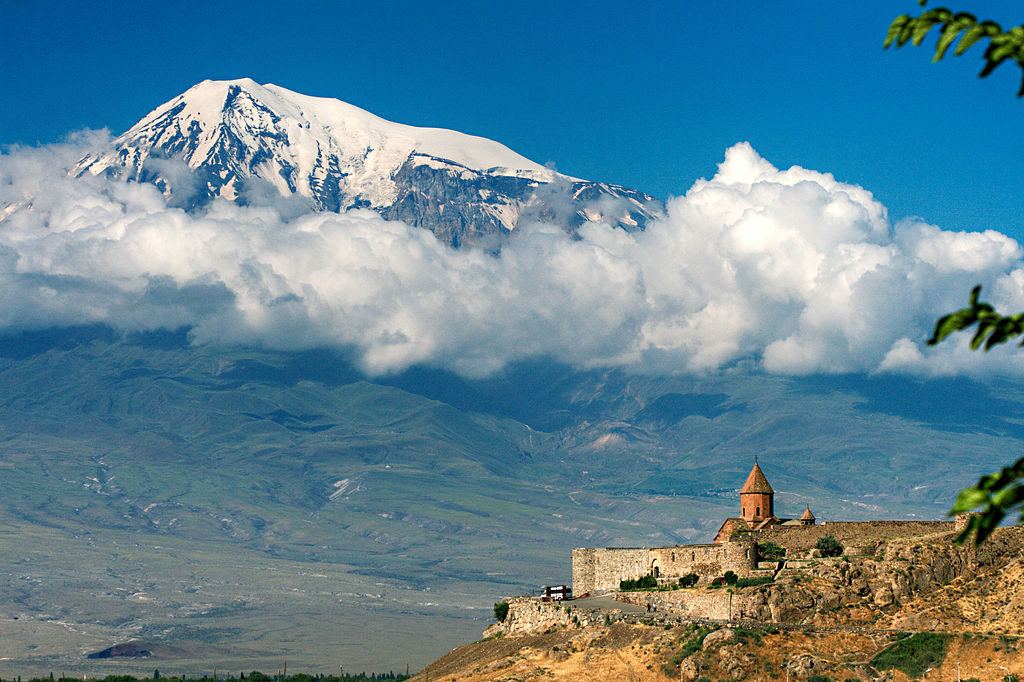
Photo: Kohrvirab MrAndrew47 (wikicommons)
Another popular day trip takes in the Gorni Gorge and Geghard Monastery. You can also stay overnight in the Gorni village.
As far as cities go, there aren’t that many significant ones in Armenia (there’s only 3 million people!). But there is Guymri north of Yerevan, a cool hipster town with unique black-and-peach architecture, and Goris in the south, which is a great base for exploring the sights of southern Armenia.
For hiking, hands down your best bet is the Dilijan National Park. Dubbed the Alps of Armenia, the area is full of charming little towns, historical monasteries, crisp mountain lakes, and gorgeous hikes through leafy forests and majestic hilltops.
What to Know Before Visiting Armenia
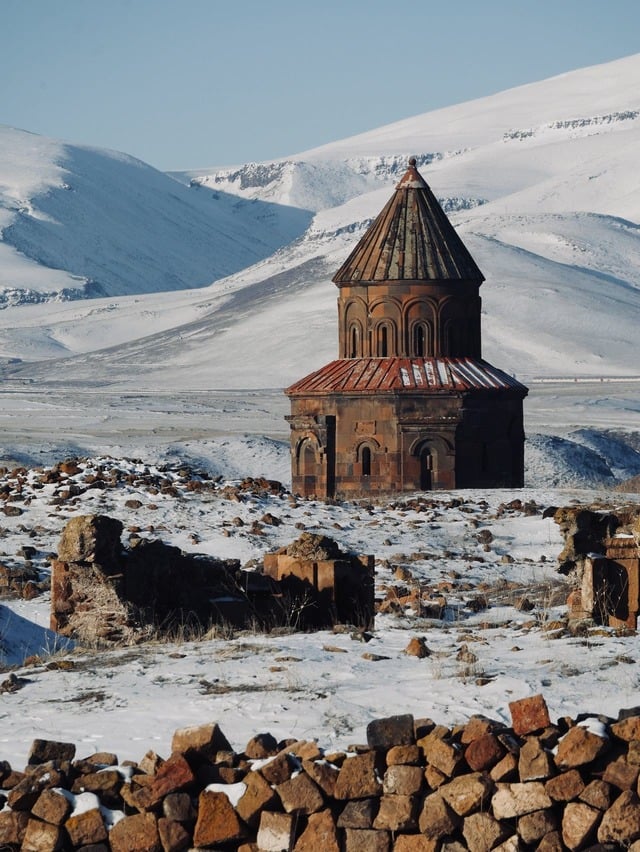
- Don’t miss out on… the Armenian Genocide Memorial & Museum. It’s dedicated to the lives lost in the genocide by the Ottomans. The accompanying museum tells stories of the victims and survivors. It’s not a pleasant place to visit but very important for understanding the history of the country.
- Keep an eye out for… Monasteries. They are EVERYWHERE.
- The coolest hostel is… Envoy Hostel. Cheap, central, and one of the most social hostels in Yerevan – everything that a broke backpacker is looking for.
- The best food is found in… Mountains and small towns. It’s the best way to experience local cooking!
Backpacking Azerbaijan
Backpacking Azerbaijan is the real treat for a backpacker craving something cool and novel – a proper offbeat destination. Azerbaijan is kinda the odd guy out of the three: mostly Muslim instead of Christian, arid instead of green and mountainous, and more tied to its Soviet history than Armenia and Georgia put together.
Most visitors make the capital, Baku, their main (and only) stop. The capital does arguably have the most to offer: a beautiful old town reminiscent of Middle Eastern bazaars with Soviet mementos sold in every corner and the hyper-modern landscape of the oil-rich city centre rising on the background.
Check out the architecture and exhibitions at Heydar Aliyev Centre. And definitely don’t miss the nightly light show at the Flame Towers.
Take a tour of the attractions surrounding Baku. The tour brings you to some of the top places to visit in Azerbaijan: mud volcanoes, ancient (UNESCO-listed!) petroglyphs, and a Zoroastrian fire temple.
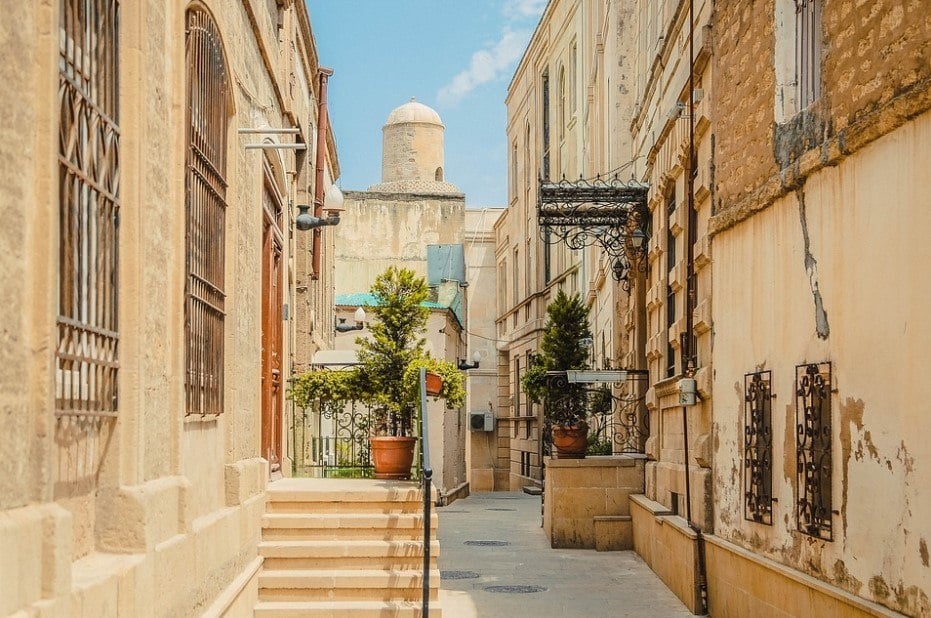
If you’re wondering what to do in Azerbaijan after this, well, there’s plenty!
Ganja, Azerbaijan’s second city, has some cool stuff to see (and its name will be the cause for constant giggles). It’s known for pretty architecture and a super-unique Bottle House built entirely of glass bottles. It’s also a great base for a day trip to Naftalan, a spa town where you can bathe in oil.
Then there’s Sheki, a small, quiet town with a beautiful old palace and unique cuisine.
Make a stop at one of the many mountain towns for a glimpse of the traditional lifestyles or adventurous hiking (most trails are not marked…). The villages are one of the BEST places to visit in Azerbaijan. My favourite is Lahic which can be visited as a day trip from Baku. Another fan favourite is Quba from where you can explore the Xinaliq village.
What to Know Before Visiting Azerbaijan
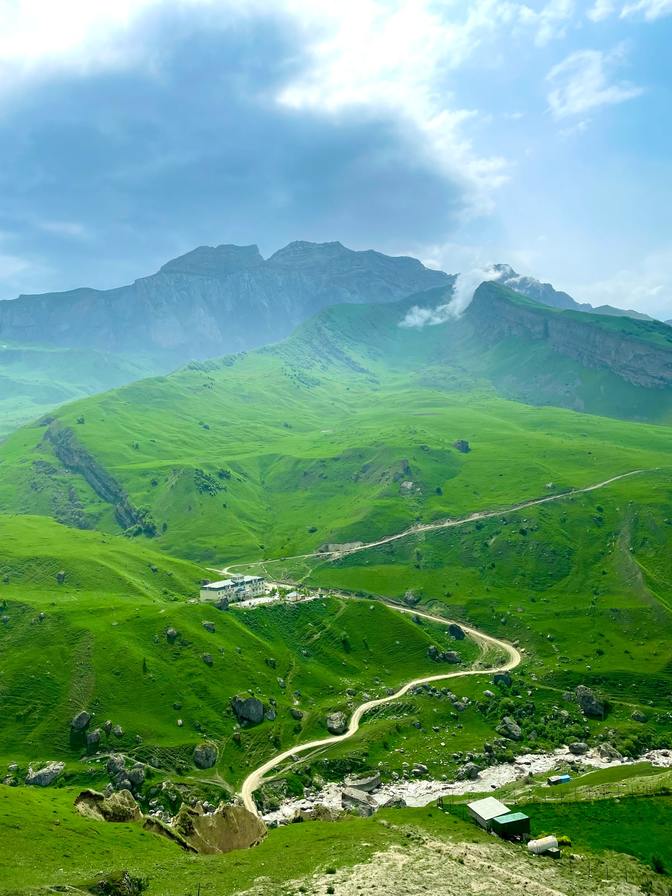
- Don’t miss out on… Sunset walks on the promenade in Baku.
- Keep an eye out for… the dress code. Azerbaijan is a Muslim country so you’re expected to dress more modestly than in Georgia or Armenia.
- The coolest hostel is… SAHIL Hostel & Hotel. The biggest and busiest backpacker hostel in Baku is known to be THE place to meet other backpackers, and they have a hostel bar.
- The best food is found… around the Fountains Square in Baku. It’s touristy but also where I had my best meals in Azerbaijan!
Getting Off the Beaten Path in the Caucasus
How about making a stop at a contested region? The Caucasus has no shortage of strange borderline areas.
Georgia – Abkhazia
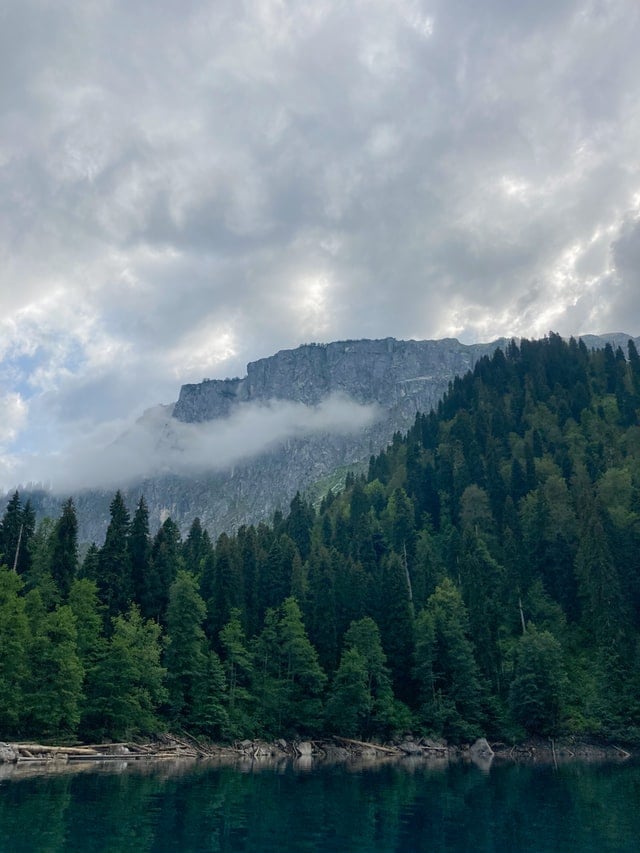
Abkhazia is legally a part of Georgia but occupied by Russia. You have to apply for a visa (a bureaucratic nightmare – my application never even went through!).
It’s safe enough to visit but protect yourself from petty theft. See the capital Sukhumi which is supposed to be an absolute treasure trove for urban explorers. Check out beach towns Gagra and New Athos, and the beautiful Ritsa Lake where you can visit Stalin’s old summer house.
(South Ossetia is another contested region but you can’t visit from Georgia. You can only enter from Russia.)
Armenia – Nagorno-Karabakh
Nagorno-Karabakh (or Artsakh in Armenian) is a region wedged between Armenia and Azerbaijan. It’s also the cause for a decades-long conflict and sour relationships between the two.
Artsakh is legally considered a part of Azerbaijan but it is under Armenian control. Note that you currently CANNOT VISIT. The conflict flared up again last year, and currently all tourism is prohibited. Hopefully it’ll be safe to travel to again soon!
The capital, Stepanakert, has a few small museums, some decent restaurants, and a monument called ‘We Are Our Mountains’. Hiking is also great!
DO NOT VISIT Artsakh if you’re heading to Azerbaijan afterwards. It will get you into huge trouble since Azerbaijan considers that an illegal entry.
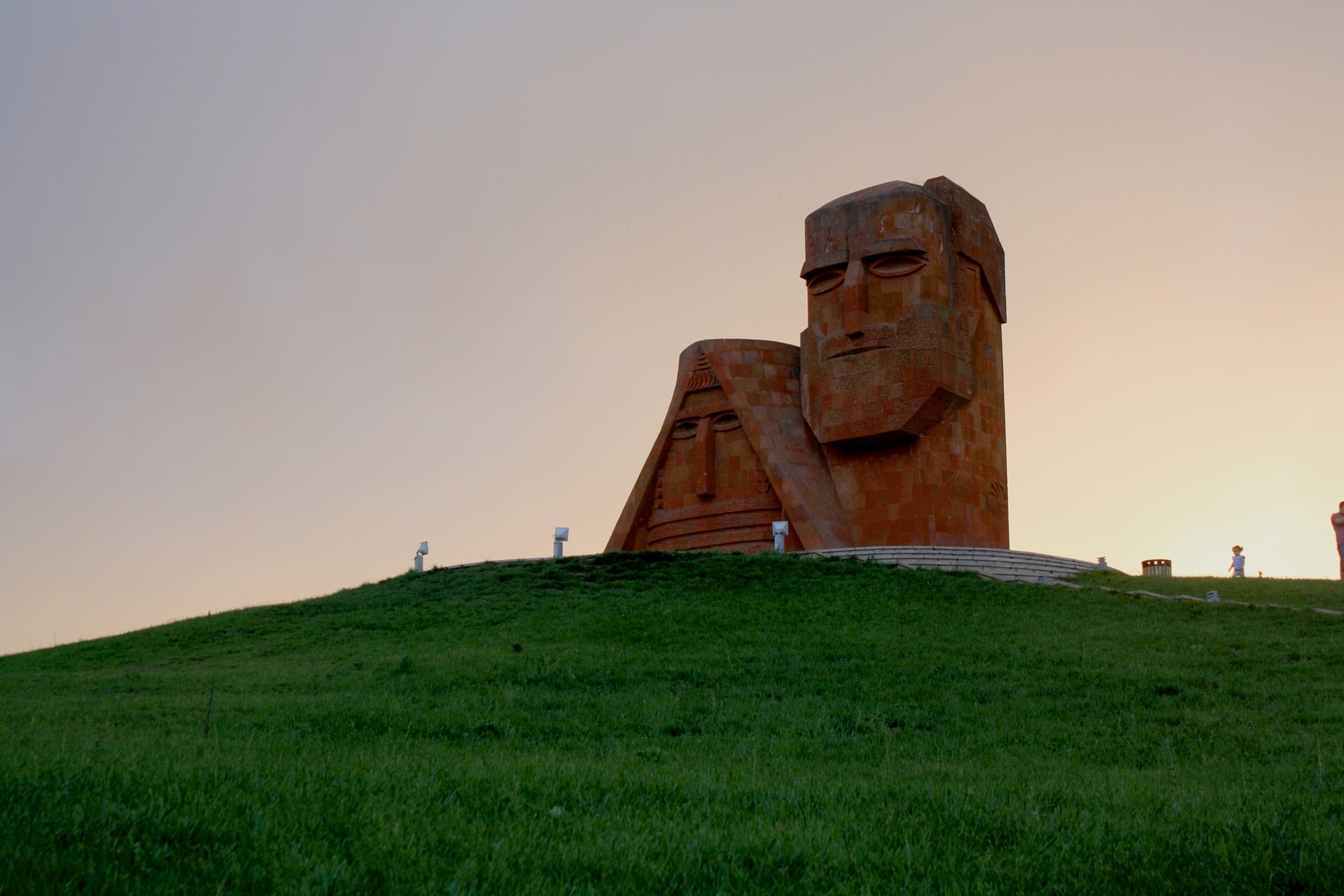
Azerbaijan – Nachivan
Then there’s Nakhchivan; an autonomous, land-locked region that belongs to Azerbaijan without actually sharing any of its borders. It’s accessible by a short flight from Baku and it’s one of the most unique places to visit in Azerbaijan.
You can visit salt mines, remote national parks, and the Mausoleum of Noah, all this set in a very self-sufficient economy built between Islamic monuments and Soviet-era buildings.
And unlike the other regions on this list, Nakhichivan isn’t actually contested or dangerous to visit. Oh joy!
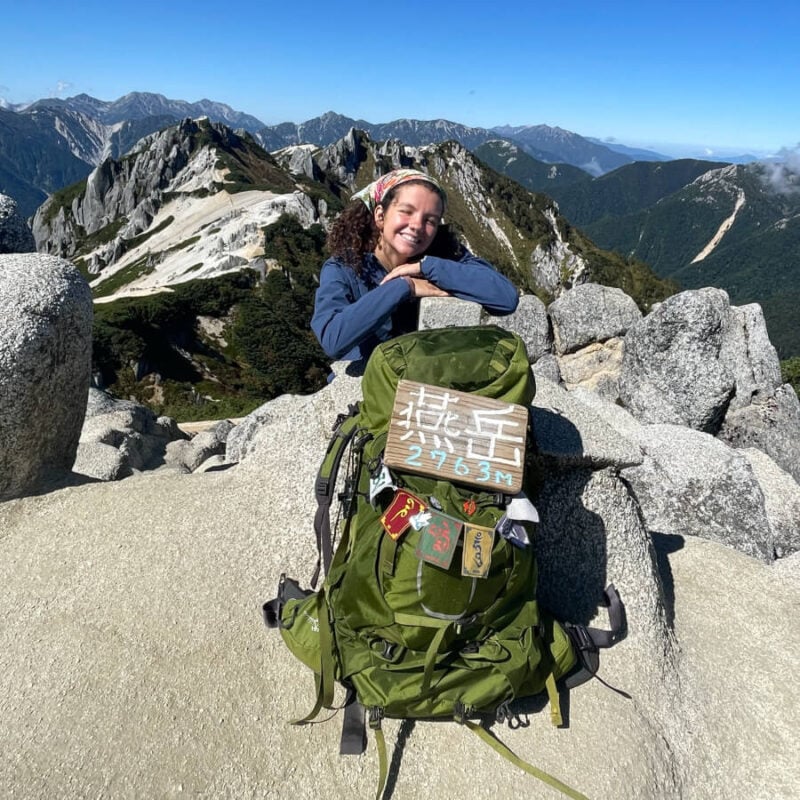
We’ve tested countless backpacks over the years, but there’s one that has always been the best and remains the best buy for adventurers: the broke backpacker-approved Osprey Aether and Ariel series.
Want more deetz on why these packs are so damn perfect? Then read our comprehensive review for the inside scoop!
View on Osprey View on REITop 10 Things to Do in the Caucasus
How much time do you have, exactly? You could spend weeks exploring this beautiful region, and it’s not all mountains and stuffing your face with delish dishes. (Although that is a big part of an adventure in the Caucasus.)
These are some of the best things to do in the Caucasus.
1. Go Trekking Caucasus Mountains
The region is bloody FANTASTIC for hikers – trekking in the Caucasus is next level. Pack your hiking boots! Georgia has the best trails, with Armenia as a close second. Even Azerbaijan isn’t completely off the race with some shorter, less explored mountain trails on offer.
Georgia, Kazbegi, and Svaneti are the most popular hiking regions. When you’re looking for the best places to visit in Armenia, you simply can’t beat the Dilijan National Park.
2. Watch the Sunset from the Top of Yerevan
One of the best experiences I had in Armenia was watching the sunset from the Cascade, a giant stairway in Yerevan. I liked it so much that I went there every night when I was in Yerevan!
This is a hang-out spot for both tourists and locals. The Cascade has amazing views over the city and, in clear weather, you can even see Mount Ararat. Don’t miss out on the sculpture garden below.
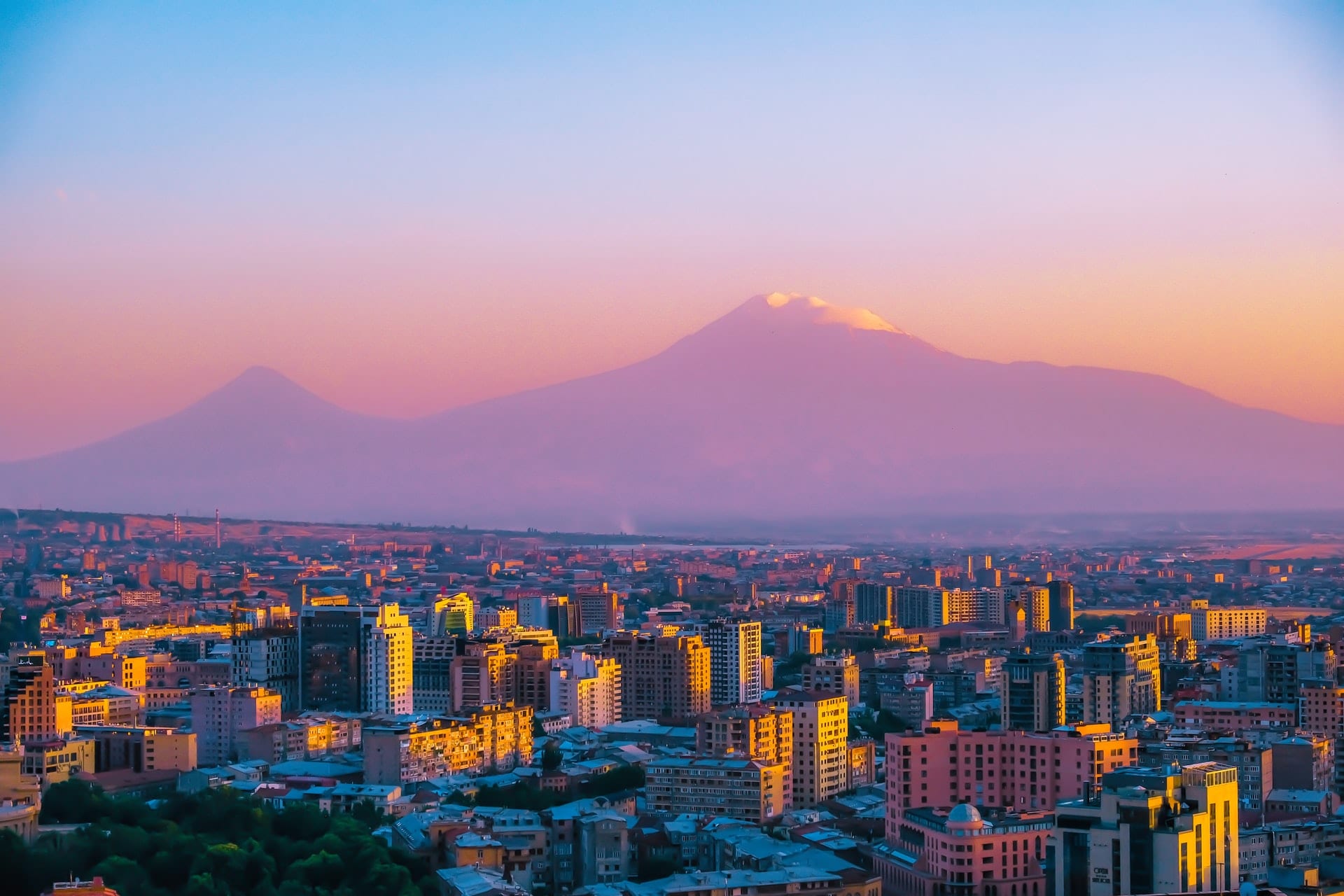
3. See the Light Show at Flame Towers in Baku
Every night after dark, Baku’s most famous landmark is lit up. The multi-coloured LED images include a dude waving the Azeri flag and changing colours. One of the most unique things to see in the city for sure – and completely free.
4. Drink Wine!
Both Georgia and Armenia claim to have been the first countries in the world to make wine. Who’s right? I think you’ll just have to try wine in both to make a sensible judgement – lots of it.
An honorable mention to Azerbaijan who is not claiming anything. They’re just happy to offer up some delicious wine in general.

Photo: Campus France (Flickr)
5. Stay at a Homestay
In countries with somewhat under-developed tourist infrastructure, homestays are a popular budget accommodation option alongside hostels and guest houses. Staying with a local family is one of the most authentic ways to experience Georgia, Armenia, and Azerbaijan.
Hospitality is deep-rooted in the culture, and the people are some of the friendliest that I’ve met!
6. Get Religious
The Caucasian trio is very religious, each country in their own way.
Georgia and Armenia are both deeply Christian. While backpacking Georgia, you can visit tons of unique churches and monasteries, usually decorated with the “Georgian cross” – a cross made of vine branches. The best church is Gergeti Trinity Church in Kazbegi.
When you travel to Armenia, the most important monastery is Khor Virap. Most of the original structures from the 7th century have obviously been destroyed. However, you can still go down the ladder to the claustrophobic prison cell where Saint Gregory (the OG Christian in Armenia) was imprisoned for 14 years.
Azerbaijan is a majorly Muslim country, so you’ll get to see lots of beautiful mosques!
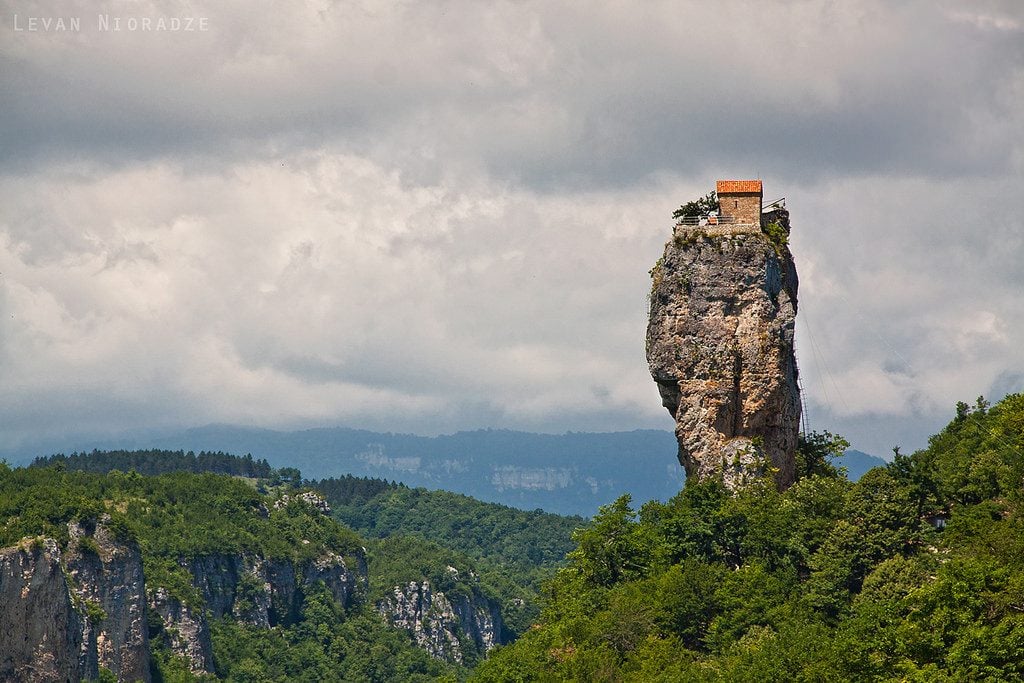
Photo: Levan Nioradze
7. Party It Up in Georgia
The Black Sea is famous for its raucous lifestyle. And Batumi? Just call it Georgia’s Sin City. Stay out all night dancing, and then snooze on the beach the next day.
Tbilisi’s nightlife is also dope. I loved Friday nights bar-hopping from one cool riverside bar to another or just sipping wine, watching the sun go down from one of the many restaurants located up on the hill.
Tbilisi is also home to Bassiani, a huge club located under a sports arena. Surely one of the top things to do in Georgia for techno lovers!
8. Explore Mud Volcanoes and Petroglyphs
A whopping 350 mud volcanoes make Azerbaijan the number one in the world when it comes to these bubbling pyres. (There are only 700 in the entire world.) The mud volcanoes are located just outside of Baku and easy to visit on a half-day trip.
Another famous attraction outside of Baku: UNESCO heritage listed petroglyphs, AKA cave paintings, include images of animals, plants, hunting scenes, and the people and culture from pre-historic times.
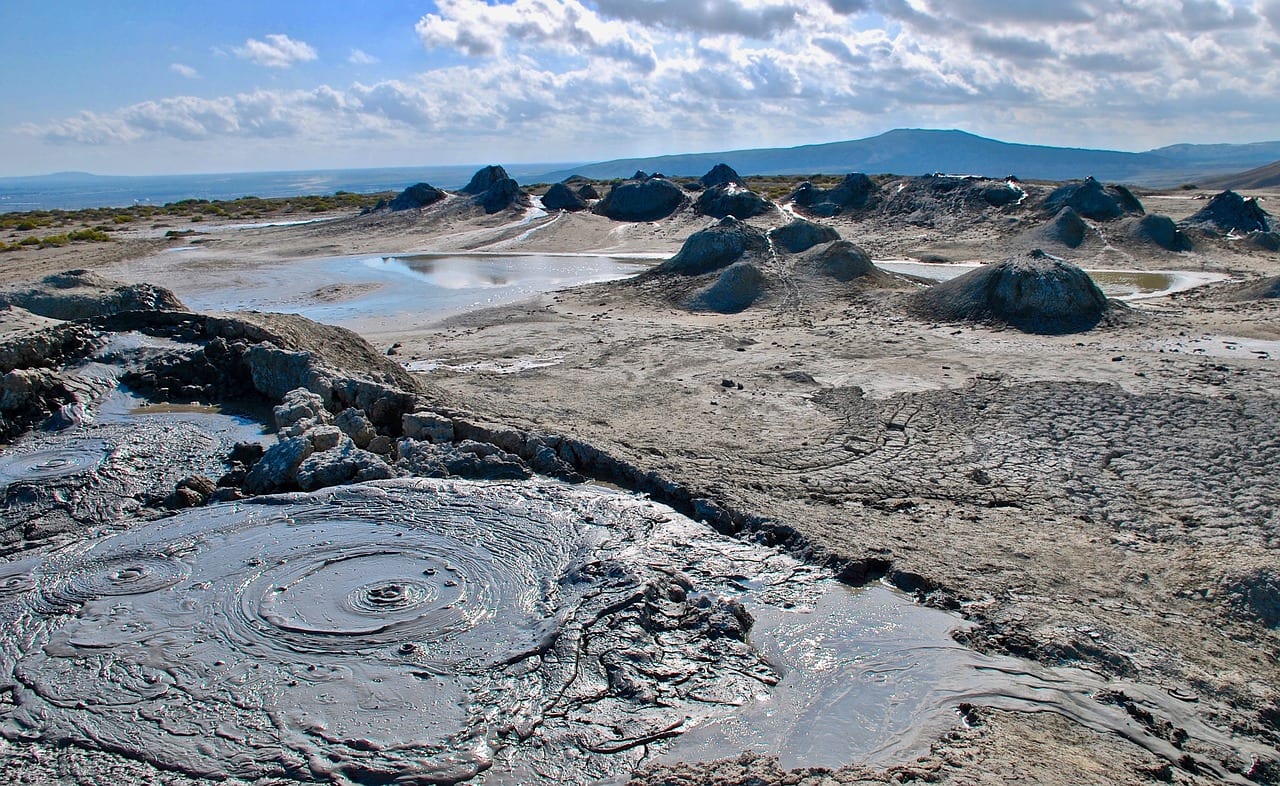
9. Eat, Eat, EAT!
Khinkali is a Georgian dumpling that looks kinda like a melted spring onion. It tastes DELICIOUS. But the Caucasus in general has incredible food: eggplants cooked in different ways, walnut sauces, kebabs, ultra-cheap greasy donuts sold in roadside stalls, and pomegranate seeds sprinkled on top of everything.
10. Pet the Street Dogs in Tbilisi
In Tbilisi, you’ll see many stray animals. But, unlike most other places, all the little critters look very healthy and happy.
In fact, there is a municipal programme to sterilise and vaccinate street animals as well as to build shelters and feeding points for them around town. So, in general, Tbilisi doggos are very friendly and happy to get petted.

Wanna know how to pack like a pro? Well for a start you need the right gear….
These are packing cubes for the globetrotters and compression sacks for the real adventurers – these babies are a traveller’s best kept secret. They organise yo’ packing and minimise volume too so you can pack MORE.
Or, y’know… you can stick to just chucking it all in your backpack…
Get Yours Here Read Our ReviewBackpacker Accommodation in the Caucasus
Whatever your preferred accommodation type is, the Caucasus is incredibly affordable.
For traditional backpackers, Georgia is the best in terms of budget hostels. There are tons!
Tbilisi has the best hostels but there are at least a few dorm-style accommodations in all the major tourist destinations. Even on the mountains, it’s possible to find backpacker hostels, but pretty much only in Stepantsminda (Kazbegi) and Mestia (Svaneti).
Armenia and Azerbaijan are both still trying to find their way to the regular backpacker trail. (Give them time.) Yerevan and Baku both have a smattering of backpacker hostels, even some pretty good ones. Outside the capitals, the selection gets pretty narrow and even non-existent.

Armenia has more hostels than Azerbaijan does, but both countries suffer from the same issues: even when there is dorm-style accommodation, there might not be other backpackers. So, prepare for some awesome solo adventures.
In smaller or more remote destinations, the cheap accommodation options are mostly family-run guest houses and homestays. There are some really awesome ones, and guest houses can be a great way to get in touch with the local life and try out some authentic home cooking.
I will never forget the delicious meal that I had at a guest house in Svaneti. The family’s 98-year-old grandma made the whole meal and her daughter and granddaughter served it.
Bonus tip: pack up a tent and a lightweight sleeping bag, because wild camping is free and allowed in all three countries.
Caucasus Backpacking Costs
Hey, guess what – Caucasus is cheap as hell yooooo. Well, it’s not quite South-East Asia prices, but it’s some of the lowest daily travel costs you’ll find in Europe.
Georgia is cheap. Azerbaijan is cheap. Armenia is probably the cheapest of the three, but there is barely any difference. In all three countries, it’s pretty easy to find a hostel for about $10 per night, eat out at $5, and take a minibus for a few bucks.
(Just watch your wine consumption… The wine is cheap but all those glasses start adding up quickly!)
It’s pretty reasonable to plan for $20-30 per day if you’re budget backpacking.
A Daily Budget in the Caucasus
| Country | Dorm Bed | Local Meal | Bus/Train Ride (three hours or less) | Average Daily Costs |
|---|---|---|---|---|
| Georgia | $12 | $7 | $5 | $15-30 |
| Armenia | $5 | $7 | $2 | $15-20 |
| Azerbaijan | $9 | $5 | $4 | $20 |
Travel Tips – Caucasus on a Budget
Your wallet isn’t going to lose too much weight on your Caucasus trip: travel is cheap and so many things are totally free. However, if you want to learn some tricks to save even more cash money, try these things:
- Carry a portable stove. Cooking your own food saves money, sure. But having a lightweight stove with you is a grand idea anyway. A great backpacking stove saves your ass in hostels that don’t have a kitchen. And if you’re gonna get your hike on, you’ll need it in the mountains!
- Grab a tent. Did I mention trekking Caucasus is an unmissable experience? Oh, about a kazillion times? Then definitely pack a waterproof backpacking tent to save on accommodation or to get more familiar with the local wilderness.
- Hitchhike! Finding a ride in the Caucasus is easy, and thumb-travel is a very cheap (and adventurous) way to see the lands unknown.
- Surf a couch. Couchsurfing is a fantastic way to get to know locals and local life while saving money! The scene in the Caucasus isn’t big but there are some hosts, especially in the capitals.
- Travel with a water bottle. The sexiest travellers help combat the world-wide plasticapocalypse by avoiding single-use plastic. Get a reusable bottle and fill up anywhere – tap water is drinkable everywhere in the Caucasus.
Why Should You Travel to the Caucasus with a Water Bottle?
Plastic washes up on even the most pristine beaches… so do your part and keep the Big Blue beautiful!
You aren’t going to save the world overnight, but you might as well be part of the solution and not the problem. When you travel to some of the world’s most remote places, you come to realise the full extent of the plastic problem. And I hope you become more inspired to continue being a responsible traveller.
Plus, now you won’t be buying overpriced bottles of water from the supermarkets either! Travel with a filtered water bottle instead and never waste a cent nor a turtle’s life again.
Best Time to Visit Caucasus
The Caucasus has all four seasons but you can visit any time of the year. Here’s a breakdown of all the seasons and the best times to visit:
Winter: A fantastic time to be in the area if you’re into winter sports. Winter in the cities is mild (a few degrees Celsius below zero). The mountains can be up to -20 degrees Celsius.
Warning: winter is not for hikers. All trails will be covered in snow, and some mountain destinations like Tusheti in Georgia and Xinaliq in Azerbaijan will be completely unaccessible.
Spring: Eh, it’s nice, but since snow usually sticks around till June-ish, you still won’t be doing much hiking. Spring can also be rainy so it’s not my favourite.
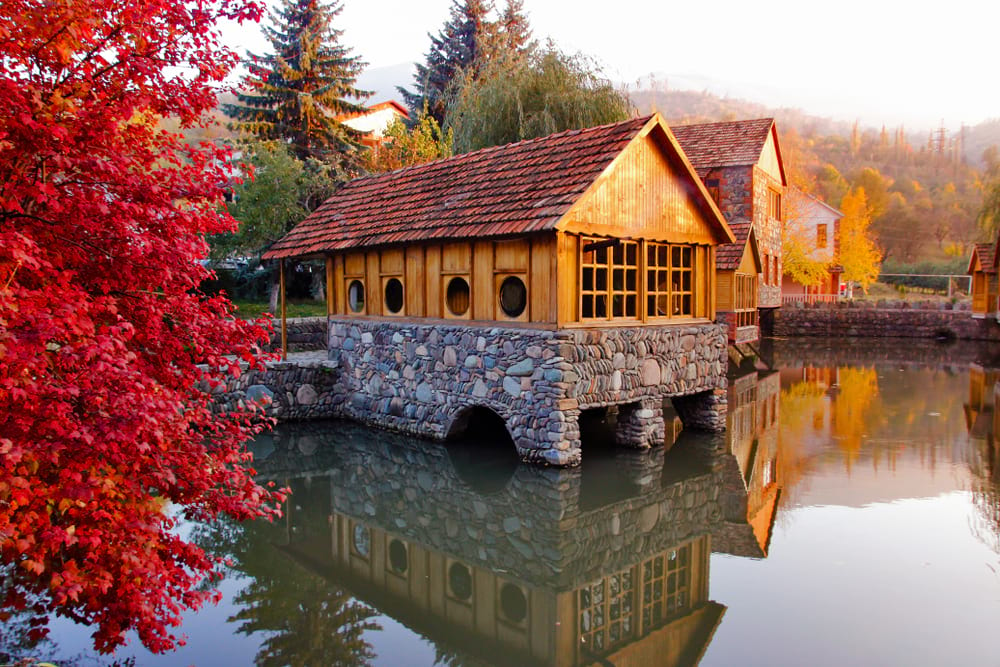
Summer: Summer, especially June-July, is the prime tourist season so it’s the busiest time to travel to Caucasus. Georgia has been getting increasingly more visitors every year. Armenia and Azerbaijan are still pretty chill even in the peak season. The summers are also the best time to visit Caucasus if you want to catch the festival season: there are plenty of cultural, art, and food festivals in all three countries from May through August.
Autumn: I LOVE autumn in the Caucasus. It’s prime weather for trekking Caucasus since the temperature is still very mild and snow is long gone. It’s also the best time to visit Armenia because the autumn colours on the mountains are just insanely pretty.
The temperatures in cities are also still warm enough to get by wearing a t-shirt and cool enough that you don’t have to keep changing said t-shirt because you’ve sweat through it.
April-May and September-October are shoulder seasons, which all savvy backpackers surely know are the best times to go.
What to Pack for the Caucasus
There are a few trusty things I always add to my backpacking packing list.
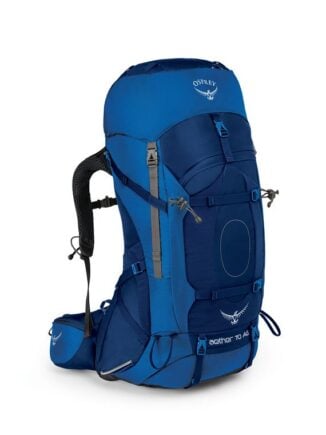
Osprey Aether 70L Backpack
Ya can’t go backpacking anywhere without a blasted backpack! Words cannot describe what a friend the Osprey Aether has been to The Broke Backpacker on the road. It’s had a long and illustrious career; Ospreys don’t go down easily.

Feathered Friends Swift 20 YF
My philosophy is that with an EPIC sleeping bag, you can sleep anywhere. A tent is a nice bonus, but a real sleek sleeping bag means you can roll out anywhere in a and stay warm in a pinch. And the Feathered Friends Swift bag is about as premium as it gets.

Grayl Geopress Filtered Bottle
Always travel with a water bottle! They save you money and reduce your plastic footprint on our planet. The Grayl Geopress acts as a purifier AND temperature regulator – so you can enjoy a cold red bull, or a hot coffee, no matter where you are.

Petzl Actik Core Headlamp
Every traveller should have a head torch! A decent head torch could save your life. When you’re camping, hiking, or even if the power just went out, a top-quality headlamp is a MUST. The Petzl Actik Core is an awesome piece of kit because it’s USB chargeable—batteries begone!

First Aid Kit
Never go off the beaten track (or even on it) without your first aid kit! Cuts, bruises, scrapes, third-degree sunburn: a first aid kit will be able to handle most of these minor situations.
Staying Safe in the Caucasus
All right, who told you the Caucasus is a dodgy place? They’re probably just trying to stop you from going because they want to keep all the awesomeness to themselves.
I know this area has sometimes had a bit of a rough reputation because of all the skirmishes with Russia. It is located a bit uncomfortably close… But the area is stable enough that that shouldn’t be a problem. If there are protests (and there are quite a few, especially in Tbilisi…) it’s best to stay away from them.
In a word: the Caucasus is super safe to travel. Even for solo female travellers. I traipsed through the whole region completely on my lonesome. Just watch out for petty theft in cities, and you’re pretty much cool to go.
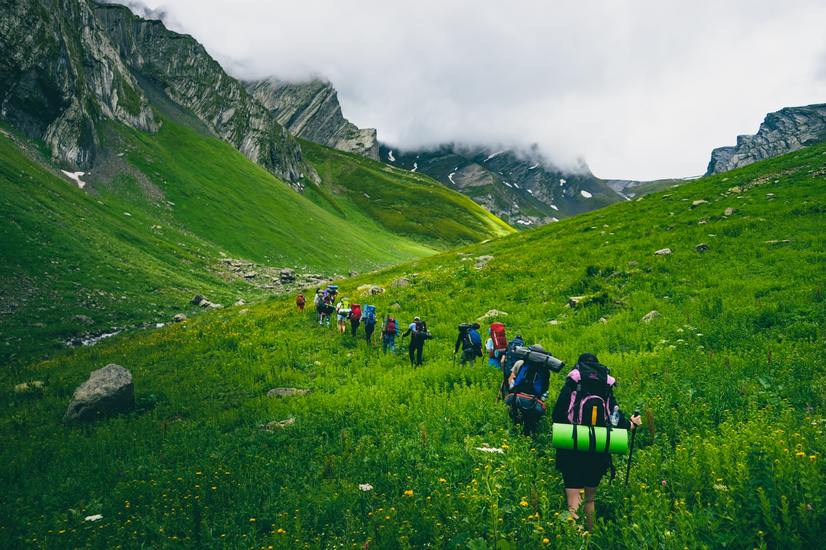
There are three special points that I need to mention:
- Traffic. The Caucasian traffic is CRAZY. Hold on for dear life, look both ways multiple times, and maybe pray to some deity or another because locals drive fast.
- Mountain safety. Many hiking areas in the Caucasus are remote and don’t see that many visitors. Make sure you’ve got a good grasp of mountain safety, especially if you’re a beginner hiker. Always tell someone where you’re going.
- Nagorno-Karabakh / Artsakh. The contested area between Azerbaijan and Armenia is a piece of explosives wrapped in some dynamite. The area had long been unstable although safe to travel – until late 2020 when the conflict flared up again. Avoid border areas between Armenia and Azerbaijan. Visiting Nagorno-Karabakh is unfortunately not possible right now. Otherwise Azerbaijan is safe, and so is Armenia
Special Precautions for LGBTQ+ travellers:
The Caucasus is a nice place… just, you know, traditional. Which means, it’s not the best place in the world for LGBTQ+ travellers. Boo.
It’s still possible to travel around and have a grand old time but it’s probably best to keep a little hush about your sexuality.
Tbilisi – probably the most open-minded place in the Caucasus – has tried to organise a pride parade for a few years now. At first it got cancelled because of the threats aimed at it, and when it did get arranged this year (2021), it led to chaotic protests on the streets. So, maybe avoid that.
Sex, Drugs, and Rock ‘n’ Roll in Caucasus
As much fun as taking drugs on the road might be, it’s very much illegal in the Caucasus, including cannabis. Having it on you could result in heavy fines and a short jail sentence. (As a foreigner you’d probably be able to bribe your way out but… probably best if you don’t put yourself at that risk in the first place.)
Luckily, there’s a whole arsenal of other weapons to choose from. Georgia and Armenia are in friendly rivalry between who was the first country to start making wine. Whichever the first one was, the result is equally delicious.
Drinking wine is actually one of the best things to do in Georgia. Wineries still make wine using the traditional methods which means fermenting the wine in clay pots underground. This means that Georgian wine is almost always red and sweet.
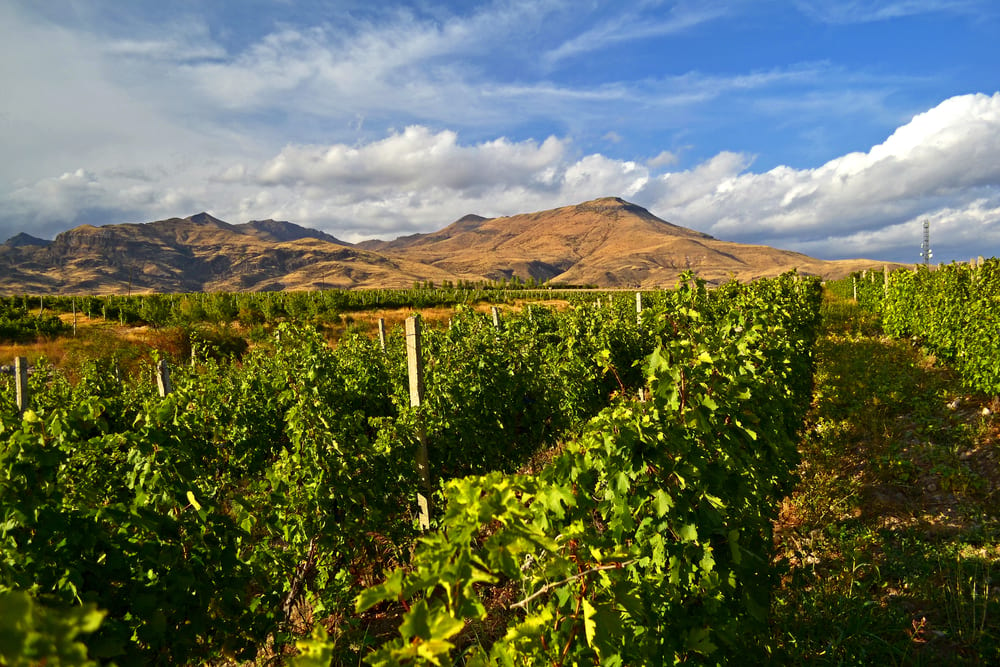
Many Georgians also like to make their own wine. Befriend a local family and they’ll probably offer you a delicious homebrew in a 1.5 litre Borjomi water bottle. I got one after hitchhiking with a friendly couple!
Every country also has their own liquor and they’re all very, very strong – proceed with caution! In Georgia it’s chacha (grape vodka), in Armenia oghi (fruits and berries vodka), and in Azerbaijan, aragh (just means vodka).
The nightlife is still catching up to the rest of Europe but it’s not completely hopeless, especially if you’re in the capitals. Batumi by the Black Sea is also a renowned party destination, but Tbilisi is the best. It has a variety of cool underground bars, craft beer spots, and the biggest techno club in the country. Bassiani is often dubbed the local Berghein and is – according to my techno-loving friends – one of the best techno clubs in Europe.
Getting Insured BEFORE Visiting Caucasus
No matter where you are or what you do, you’re always at risk to slip in the shower or throw out your back out partying too hard in the neon lights of Batumi.
A savvy backpacker should always consider getting a comprehensive travel insurance before leaving home. A travel insurance policy covers you from little boo-boos to 127 hours-style predicaments.
ALWAYS sort out your backpacker insurance before your trip. There’s plenty to choose from in that department, but a good place to start is Safety Wing.
They offer month-to-month payments, no lock-in contracts, and require absolutely no itineraries: that’s the exact kind of insurance long-term travellers and digital nomads need.
SafetyWing is cheap, easy, and admin-free: just sign up lickety-split so you can get back to it!
Click the button below to learn more about SafetyWing’s setup or read our insider review for the full tasty scoop.
How to Get Into Caucasus
All three Caucasus countries are connected fairly well to the outside world. (Well, at least their capitals are.) But the best and cheapest way to get in is usually through Georgia.
Flying to the Caucasus
There is a surprising amount of cheap flights in and out Georgia. There are three airports that you can use to enter and exit Georgia internationally: Tbilisi, Kutaisi, and Batumi.
Tbilisi is the most populated port of entry for air traffic, and has the most options. Batumi and Kutaisi both have smaller airports but with many airline options. For the cheapest cheapskates, Kutaisi airport has Wizzair flights.
To fly into Armenia – Yerevan is the most convenient entry point. Some major airlines, like Lufthansa and Qatar, operate there, although chances are you’ll struggle to find a direct flight there.
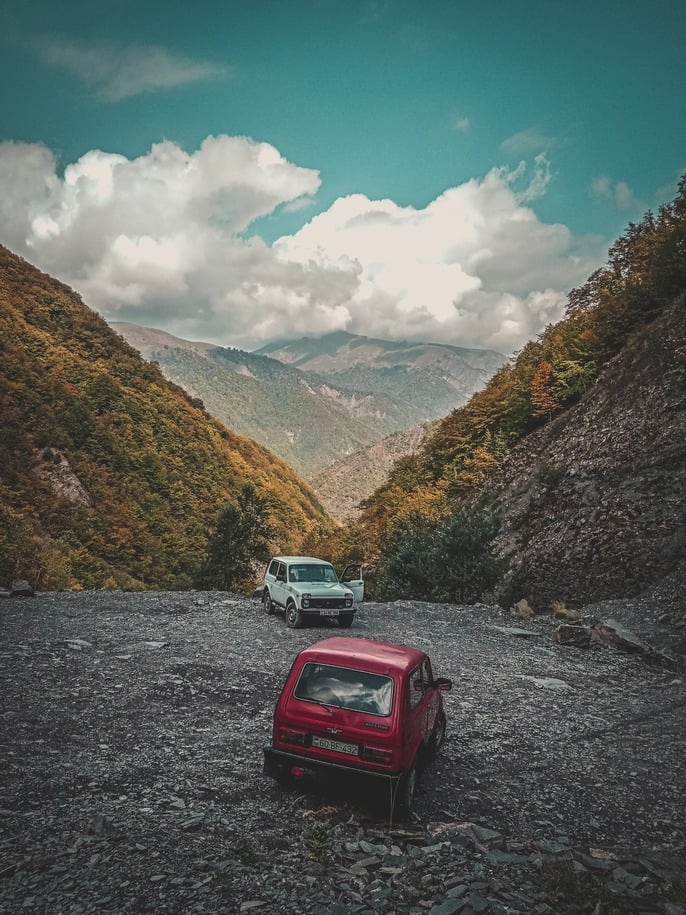
Baku in Azerbaijan also has a decent little airport. Your best bet of finding a direct flight is with the national airline, Azerbaijan Airlines.
Getting into the Caucasus Overland
Buses and trains are a cheap way to get to all three countries, depending where you’re coming from!
To Georgia – There are buses from Istanbul, Turkey, that can take 30+ hours, but the views on the way are worth it. From Russia, there is another 30+ hour bus available from Moscow. The only international train lines are to and from Armenia and Azerbaijan, unfortunately!
To Armenia – It is NOT possible to travel directly from Azerbaijan or Turkey, so the only overland point of entry to Armenia is through Georgia or Iran. You can take an overland bus from Tehran or Tabriz all the way to Yerevan.
To Azerbaijan – Again, you can NOT enter Azerbaijan from Armenia, so the only overland travel options are Georgia and Iran. From Iran, you can get to the border with a bus, cross the border by foot and take a taxi on the other side of the border to the train station to get to Baku. There are also buses from Tehran to Baku.
Entry Requirements for the Countries in the Caucasus
Entering Georgia is super duper easy for most travellers: EU citizens plus travellers from 40+ countries can enter without a visa and stay for up to one year. Yay!
For countries that require visas for Georgia, there’s a handy e-visa portal that is enough to get you the visa to visit. Some nationals have to visit a Georgian embassy to get a visa. Find out what the visa requirements are for you on the Georgian visa page here.
Citizens from 45 countries can get a free – that’s right, FREE – visa when you travel to Armenia which allows them to stay up to 180 days in a year. These countries include most of Europe, the UK, and the US, plus a few surprise guests.
If your passport is not under the free-visa scheme, that’s sad. But your trip to Armenia still doesn’t have to remain a distant dream. You can apply for a visa at a local embassy or electronically. A 21-day single-entry visitor visa costs $6, and a 60-day visitor visa that allows multiple entries (perfect for Caucasus travel?) is just $41.
If you’re unsure if you need a visa, there is some solid info on Armenian visa requirements here.
You do need a visa to enter Azerbaijan. But lucky you – the application process is really easy!
Most travellers can get an online visa before arrival. It takes about three days to process and costs a whopping $24. Don’t forget to print the visa out once you receive it – you need a physical print-out to enter the country.
This visa is valid for 30 days. Armenian passport holders cannot enter at all.
The e-visa is called the ASAN visa. Make sure you get it from the official government website; fake visa agents are a common travel scam.
Another essential thing to know: if you’re staying for more than 10 days, you have to register with the State Migration Service. Your hotel or hostel can usually do this for you once you arrive.

Get 15% OFF when you book through our link — and support the site you love so dearly 😉
Booking.com is quickly becoming our go-to for accommodation. From cheap hostels to stylish homestays and nice hotels, they’ve got it all!
View on Booking.comHow to Get Around Caucasus
It is cheap to travel to Caucasus, even if it’s not the most convenient experience. Distances are short but because of the road conditions, trips might take a little longer than you’d expect. Even if you might be travelling a bit rough, routes are well-set up between cities and countries!
There are two things you need to keep in mind when you start planning your Caucasus itinerary:
- Armenia and Azerbaijan are frenemies of the highest degree and it is NOT POSSIBLE to travel directly between the two.
- You need a visa to enter Azerbaijan.
But fear not – travel in the region is still pretty simple. It just means that if you want to visit all three Caucasus countries, you’ll have to go through Georgia (or Iran).
You can easily travel to Armenia AND Azerbaijan on the same trip and in either order, but I highly recommend first going to Azerbaijan, then Armenia. It’s legal to enter Azerbaijan after Armenia; you just might get asked a lot of questions, so leaving Armenia last saves you some trouble.
Travelling by Bus in Caucasus
You won’t see many “normal” buses. Instead, trips happen in marshrutkas, minibuses that share an uncanny likeness to creepy white vans.
Travelling by marshrutkas is very cheap and very adventurous. Often the vans are crammed as full as they’ll go, with extra seats pulled out to fill the aisle, and luggage strapped on the roof of the vehicle.
Bus terminals can be confusing to foreigners. There aren’t signs instructing you to the right platforms. Buy your ticket at the ticket office at the station, then walk around the station asking people to show you to the right bus.
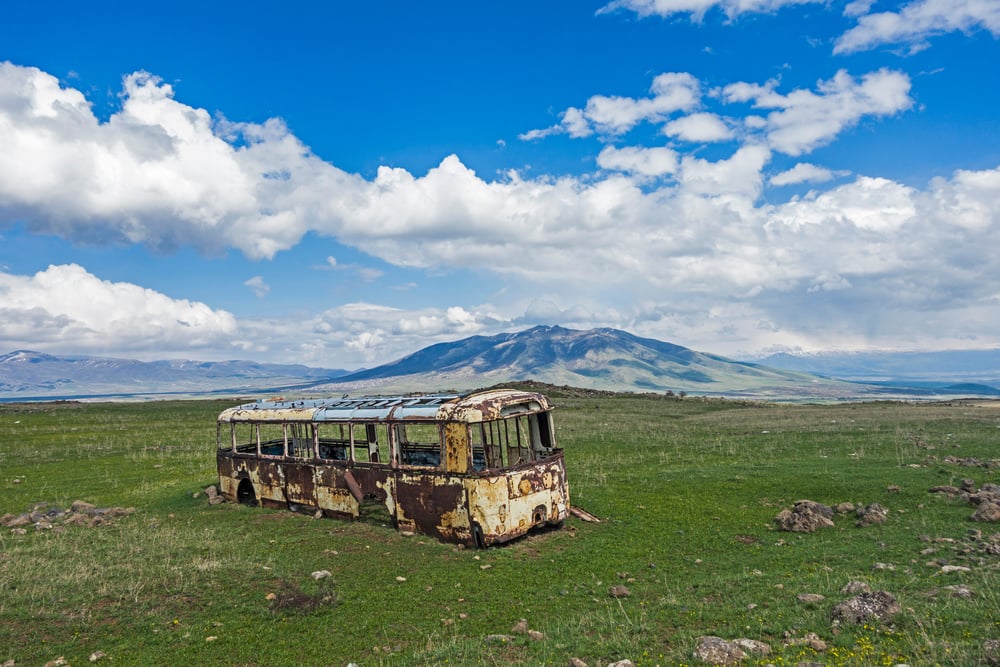
The destination name is usually written on a piece of paper on the windshield – but in the local language, which doesn’t follow Latin alphabet. So, good luck!
You can’t book marshrutkas beforehand, you just gotta show up in good time. They have approximate departure and arrival times, but in reality they only leave when they’re full.
There is a bus connection between Tbilisi and Yerevan, and Tbilisi and Baku.
Travelling by Train in Caucasus
There is an extensive railway system in all Caucasus countries. However, that doesn’t always mean that train travel is the more convenient option.
Some routes have fast, modern locomotives while some use clunking artifacts from the days of the Soviet Union. Either way, the tickets are cheap and the journeys are scenic.
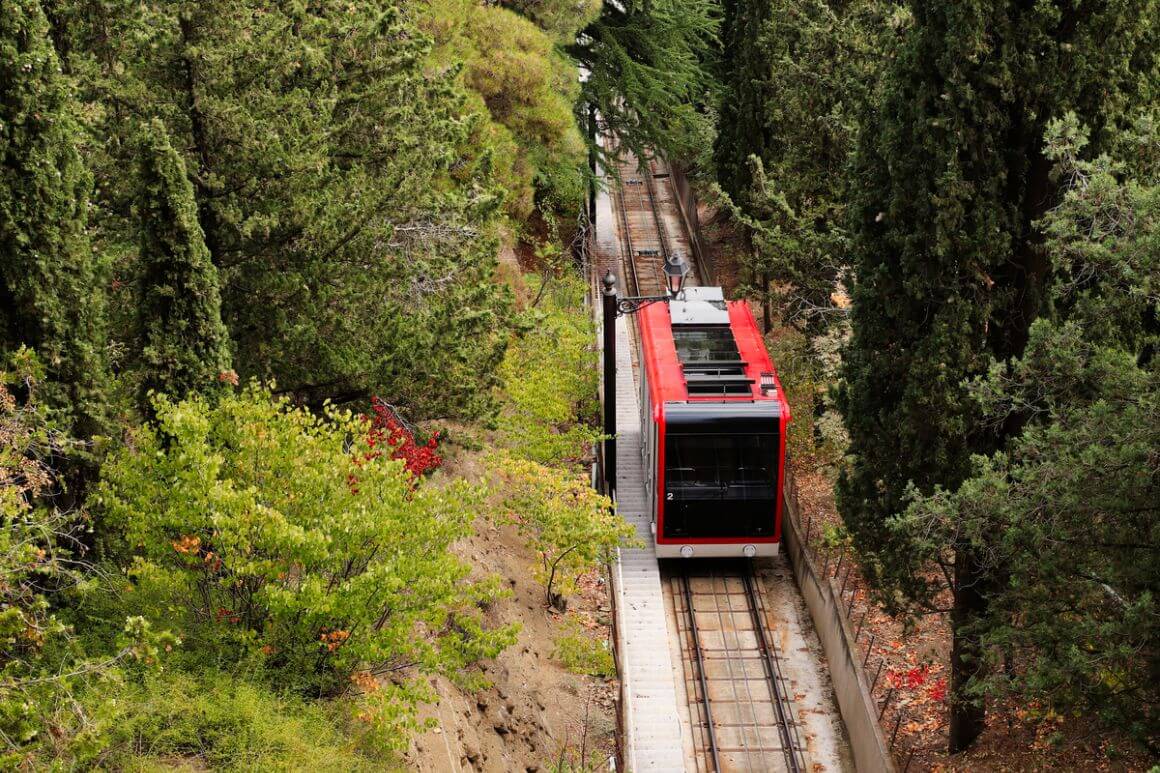
The best way to buy tickets? Buy them straight at the train station. Many backpackers seem to have trouble buying tickets online using foreign credit cards in all three countries.
There is a sleeper train running between Yerevan-Tbilisi and Tbilisi-Baku, so if you’re looking for a way to country hop, night trains are usually the most convenient.
Travelling by Car in Caucasus
I mean, yeah, in theory you can travel by car – but think twice. Most of the places you’re likely to have on your itinerary are accessible by public transport.
Plus, roads are often in bad condition. Not to mention that local drivers are a bit… how do I put this nicely… crazy. Yep, that’s it.
Driving yourself in the Caucasus is a feat reserved only for experienced drivers.
Expect potholes, chickens, reckless drivers, unpaved roads, and being surrounded by old Ladas. (Seriously, does everyone in Azerbaijan drive a Lada?) If you’re adamant on driving, have fun. It’s definitely going to be an adventure.
Travelling by Taxi in Caucasus
Shared taxis are a pretty cheap way to get around the region, actually! Especially if you can share it with someone. It might be a more flexible and quick way to get from city to city than wait for the reliably unreliable minibuses to fill up.
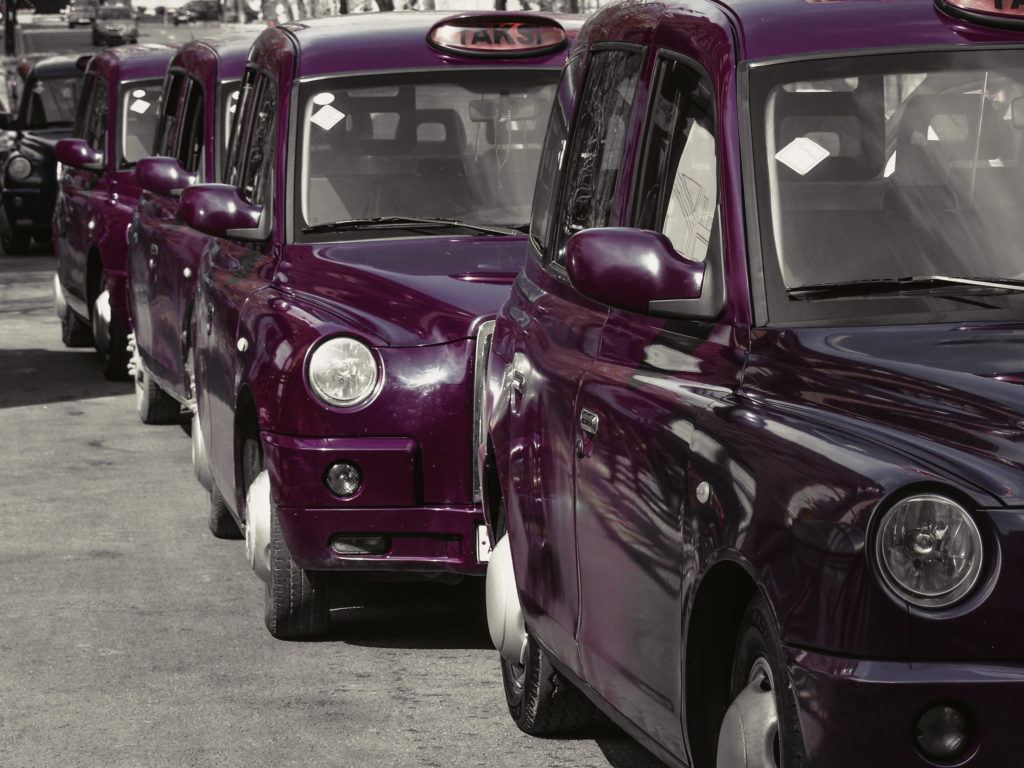
In cities, travelling by taxi is generally safe. But, if you’re a foreigner, you might be more vulnerable to getting ripped off. Bolt – a rideshare app similar to Uber – is a popular, secure, and cheap option for trips within the capitals.
There are even shared taxis operating between Yerevan and Tbilisi, and those will set up back about $35-40 (when shared!).
Travelling the Caucasus by Hitchhiking
The Caucasus in general is a great place to pick up lifts. People are friendly and getting a ride is pretty easy. In fact, locals often hitch rides with passing cars as well, so a thumb-traveller is not an uncommon sight.
Hitchhiking in the Caucasus is very safe, and a great way to meet the local people. I got a hefty taste of the famous local hospitality even during short rides. One couple stopped by their house before dropping me off so that they could give me a bottle of homemade wine. In Nagorno-Karabakh, the three older guys that drove me stopped at the best lookout spots to let me see the view!
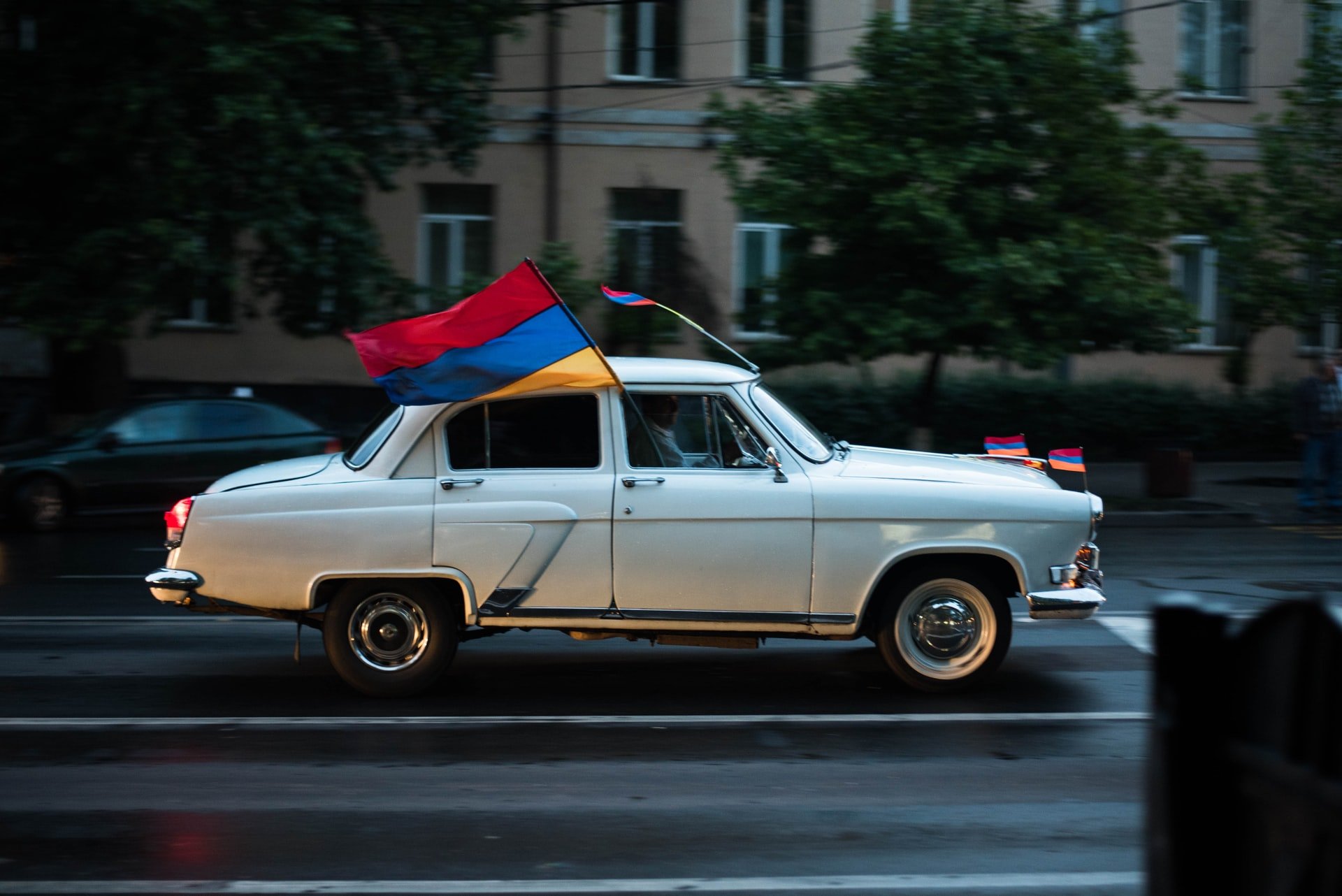
Just a word of warning: drivers in the Caucasus have a rep for being, uh, kinda aggressive in traffic. People drive fast and are seemingly nonchalant to traffic rules. In Georgia, one driver I rode with had his right arm in a sling, so he was operating his (manual) car with one hand and going down the road at 100 km/h. Yikes.
Oh, and speaking of Georgia: since there are a ton of imported cars, many cars have the steering wheel on the right side. (They drive on the right.) You can imagine how this can make the experience even more hectic…
A word from a solo female hitchhiking: finding rides was super easy all over the Caucasus. But after a while, I got cautious – just one too many creepy experiences. Maybe I was just unlucky since I’ve hitchhiked lots in Eastern Europe before without many incidents. Anyway, if you’re a solo girl hitchhiker, take extra caution accepting rides.
Onwards Travel from Caucasus
Unless you fly out, there are only a handful of land routes you can take out.
To Iran – You can cross to Iran both from Armenia and Azerbaijan. From Armenia, you can get a bus from Yerevan or Goris to Tabriz, or all the way to Tehran. From Azerbaijan, take the (night) train from Baku to Astana, where you can walk across the border and take a bus to Tehran or any other cities you’d like to.
Just remember that you need a visa to go backpacking in Iran! The visa process was fairly easy when I did it even though it requires a visit to the Iranian embassy. Both Baku and Yerevan have an embassy. British and American citizens can’t enter Iran without an organised tour.
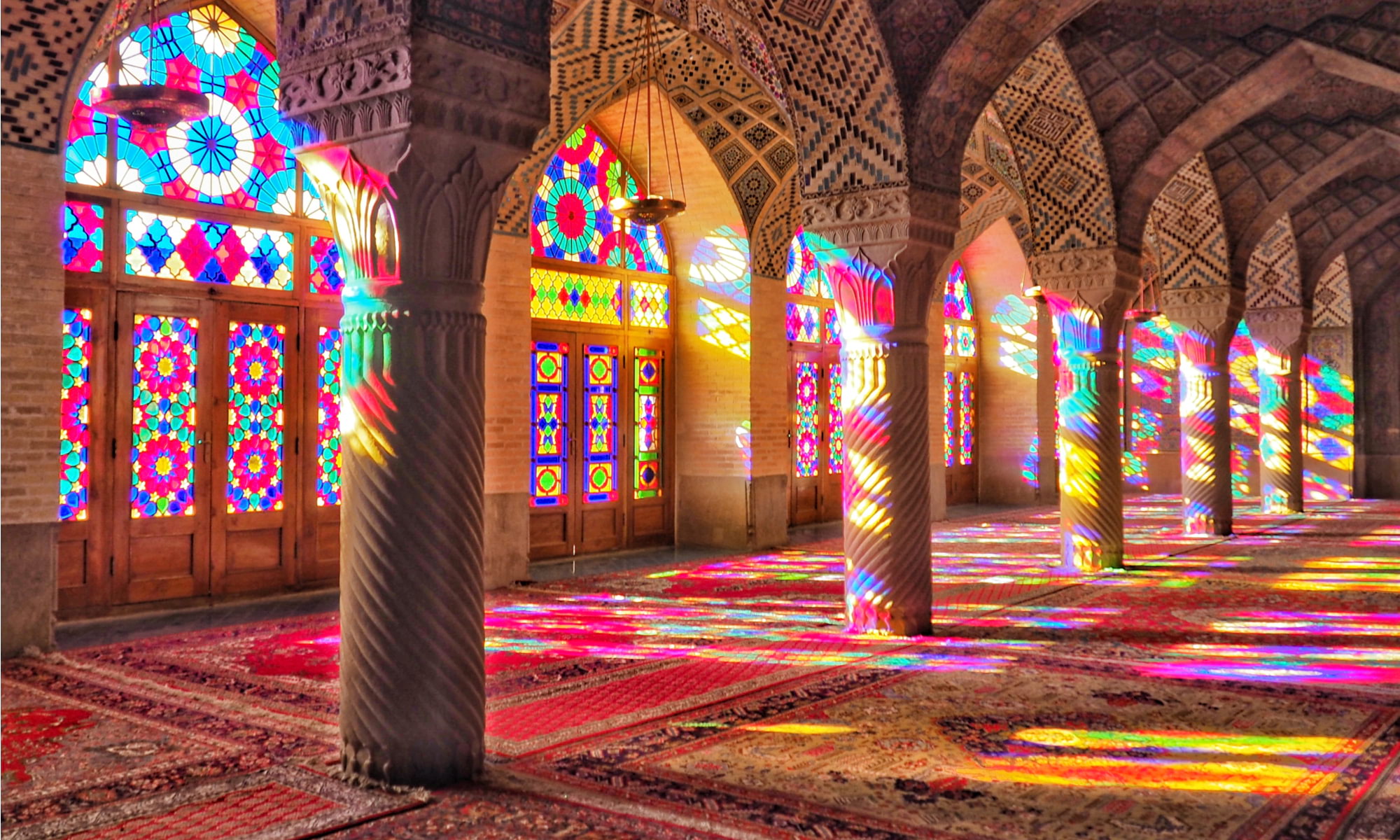
To Turkey – You can continue travelling to Turkey from Georgia; there are direct buses to Istanbul if you’re willing to brave the 30+ hour travel time. You need a visa to enter Turkey. Usually, the process is pretty easy and can be done online. It is NOT possible to enter Turkey from Armenia – the two countries are not BFFs.
To Russia – From Georgia, you can also cross over to Russia. There is just one crossing point in Georgia, in Kazbegi (north of Stepantsminda), and one in Azerbaijan. You can take a bus from Tbilisi to Moscow for about $45-65. Or you can take a train from Baku to Moscow, which might be kinda pricey.
Over the Caspian Sea – Apparently, it’s also possible to take a cargo ship operating as a ferry across the Caspian Sea from Azerbaijan. It goes to Aktau, Kazakhstan, or Turkmenbashi, Turkmenistan. From what I’ve read, this seems like a difficult, confusing process. But hey, anything for an adventure, right? (You need to sort out your visas beforehand too!)
Working and Volunteering in the Caucasus
Fell in love with the Caucasus and now you want to stay there longer? Really can’t blame you!
If you start looking for job opportunities in the Caucasus, you’ll soon notice it’s not exactly easy to find work.
Some international companies and organisations have locations in Georgia but unless you can find a job teaching English, your chances of finding a job in a Georgia-based company are pretty slim. If you want to work for a Georgian company, you need to get a long-term visa.
For work in Armenia, a visa is also required, and work might be even harder to find. You need to sort out the residency and your Armenian working visa before moving to Armenia; and for you to get the visa, you need to have already found an employer that can sponsor you.
In Azerbaijan, Baku already has a small expat community, and it is very cheap to live there. Most foreigners working in Azerbaijan work in something oil industry related but the might be opportunities in tourism and teaching as well. You do need to apply for a visa beforehand, and you usually arrange it through the employer.

A new country, a new contract, a new piece of plastic – booooring. Instead, buy an eSIM!
An eSIM works just like an app: you buy it, you download it, and BOOM! You’re connected the minute you land. It’s that easy.
Is your phone eSIM ready? Read about how e-Sims work or click below to see one of the top eSIM providers on the market and ditch the plastic.
Grab an eSIM!The Digital Nomad Scene in the Caucasus
Trust me when I say this: Tbilisi is one of the BEST cities for digital nomads in the WORLD. No, this is not me being biased! Tbilisi has great wifi, tons of nomad-friendly coffee shops and co-working spaces, heaps to do, an affordable lifestyle, AND an ever-growing nomad community. It is perfect in almost every way.
In addition, Georgia is actively encouraging digital nomads to move there. The Remote Georgia programme allows you to stay from 180 days to a year. (Or, you know, you can just get the free visa on arrival…) They have also started initiatives that allow digital nomads to work in the same offices as Georgians to help them integrate.
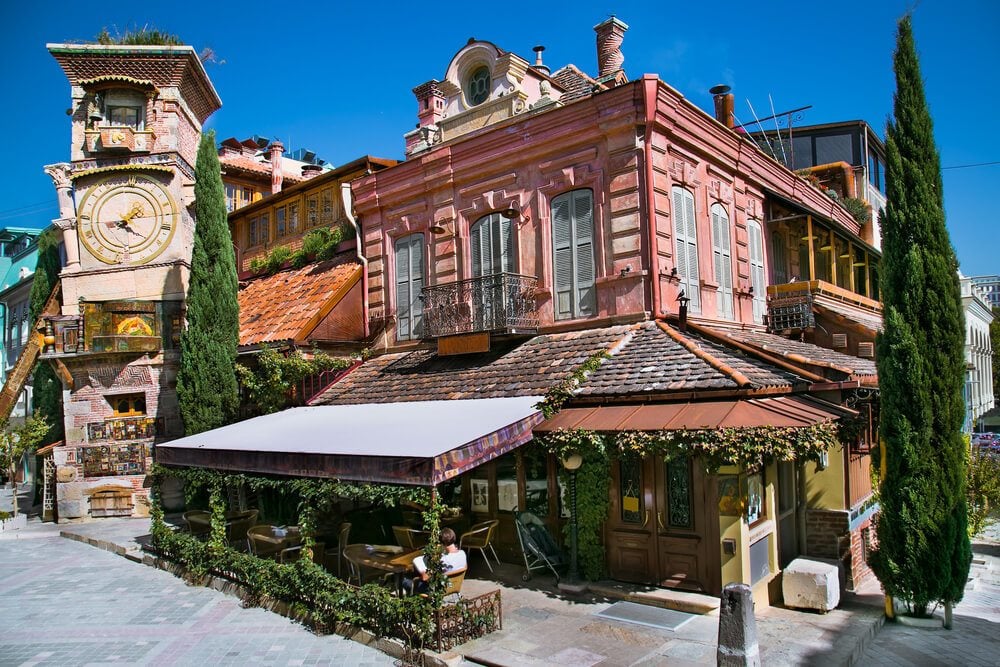
Yerevan has got everything going for it that Tbilisi does. The only thing missing is a solid nomad community but that is likely to change soon, either from the overspill from Georgia or just by people hearing how awesome Armenia is. So, digital nomads – keep an eye on Armenia.
Azerbaijan has so far not been a very popular digital nomad destination but this might change if Georgia and Armenia keep getting more popular.
However, wifi is not great, the weather is not great, not that many people speak English, and dealing with immigration is annoying. The biggest downside though is that there isn’t all that much to do. Sure, Baku is pretty – but it’s nowhere near as fun and entertaining to live in as Tbilisi.
Teaching English in the Caucasus
There is also the option of teaching English. This is especially popular in Georgia.
The Georgian government is working hard to raise the level of English spoken in the country so that it can be a big international player. This means lots of opportunities for English teachers.
Make sure you have your TEFL certification before travelling. Teaching English abroad is much smoother with the right qualifications.
Broke Backpacker readers also get a 50% discount on TEFL courses with MyTEFL (simply enter the code PACK50).
Volunteering in the Caucasus
If you’re not a digital nomad but would like to hang around still, there are definitely options to stay longer. One of the best ways to live somewhere long term is to volunteer. For the measly price of your time and labour a few hours a day, you get free accommodation and meals in exchange.
But freebies are just a bonus. The real reason you should consider volunteering on your next trip is to give back.
Volunteering attaches you to the local landscape more firmly than a regular backpacker just hastily flitting through. It is the more meaningful way to travel by creating connections and doing something good in exchange for all the awesome hospitality the Caucasus has offered you.
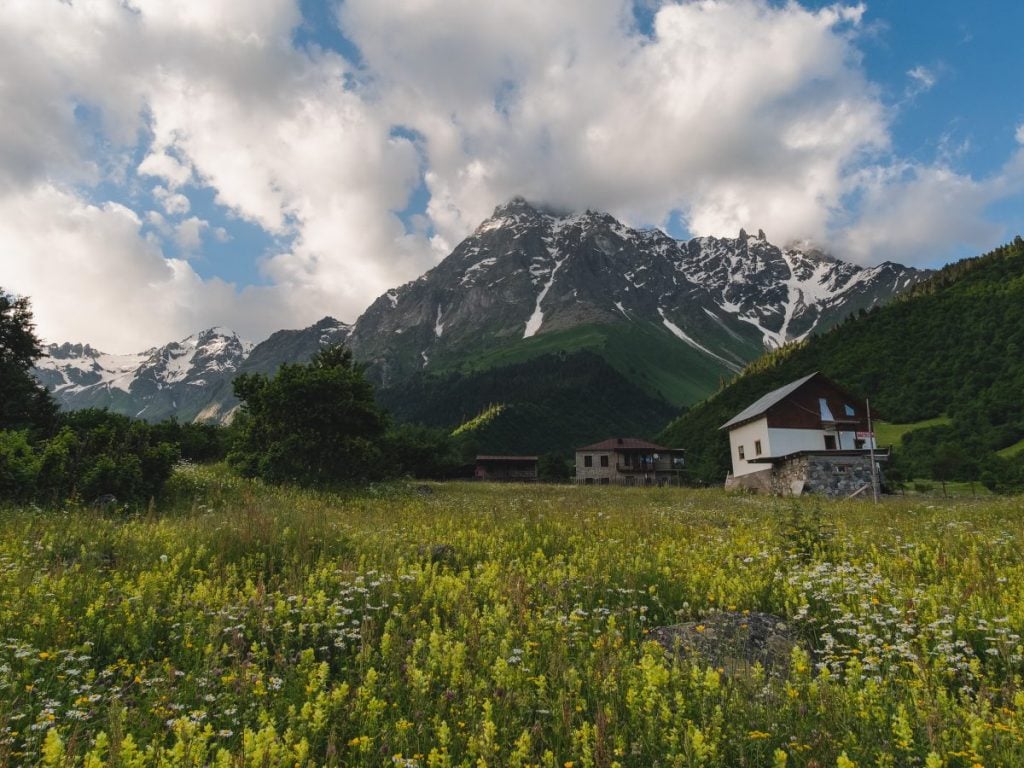
For hikers, one of the coolest opportunities to volunteer is with the folks at The Transcaucasian Trail. This trailblazing group of trekking enthusiasts has been working tirelessly to establish and mark new trails in Georgia and Armenia. If you’re planning on some hiking already, why not help them build some trails in the process?
At The Broke Backpacker, we LOVE Worldpackers. It’s one of the best work exchange sites out there with great volunteer opportunities, a communal platform to share your experiences, and a company that actually cares about you.
Workaway is another great option and it’s worth checking out, too, since the Caucasus might have limited volunteer opportunities posted online.

Worldpackers: connecting travellers with meaningful travel experiences.
Culture in the Caucasus
If I had to describe the general vibe of the Caucasus in one word, that word would be hospitable. You can see the same strand running through all countries and regions in the Caucasus.
Whether it’s welcoming visitors to their family feasts or picking up a desolate hitchhiker on the side of the road, people in the Caucasus are known to welcome travellers with open arms.
Especially in Georgia, you might get invited to a feast with a local family. Georgia has a very special toasting culture: there is a toastmaster at the table called the tamada. This is usually an older man of the family who leads toasts throughout the dinner.
And you’re supposed to toast to everything. Good health? Friendship? Getting the pothole fixed on your driveway? Raise your glasses, ladies and gentlemen. The word for cheers might be the most useful one in your Georgian lexicon: gaumarjos!
Just be careful with the chacha vodka. The only tourist I ever saw drink a Georgian under the table was a sturdy Polish man.
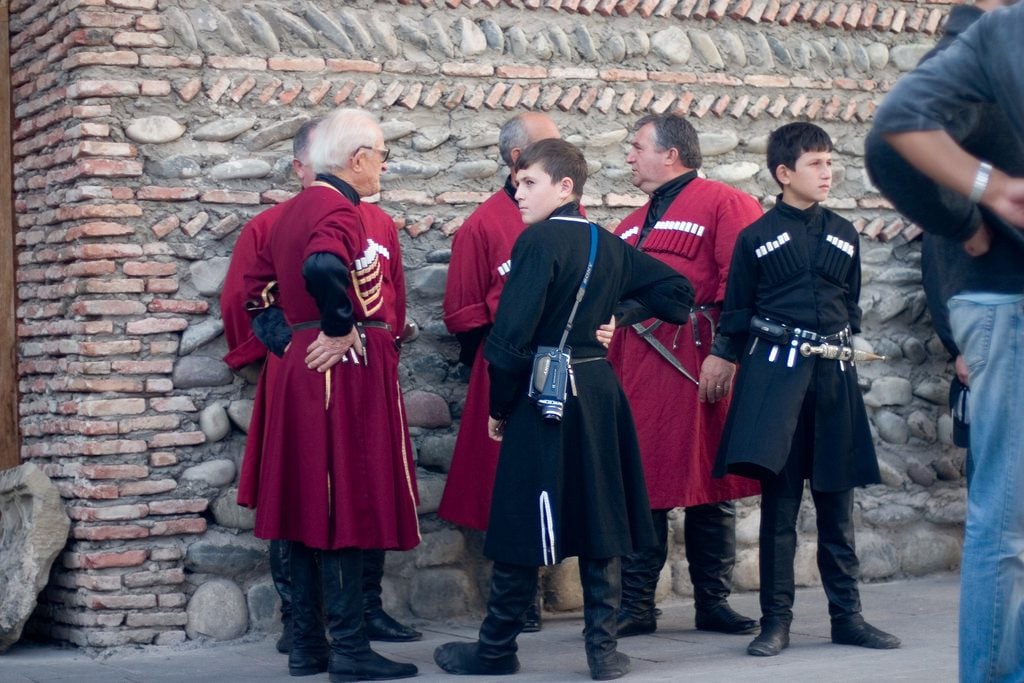
Photo: jb (Flickr)
Traditions still play a big part in everyday lives. If you only visit glitzy capitals, it’s easy to get lost in all the city culture and forget that the metropolitan lifestyle doesn’t trickle down to the rest of the country.
In large parts of the Caucasus, people still lead very traditional lives farming, herding sheep, and making crafts, even if tourism has somehow crept into that tapestry of old ways. This means that Caucasus culture can be quite conservative, especially if you step foot outside of the biggest cities (which you DEFINITELY should).
Especially in Georgia and in Tbilisi, I found it easy to meet and mingle with locals my age. They usually spoke excellent English, and I barely felt any cultural differences to elsewhere in Europe.
What to Eat in the Caucasus
Oh my god. The food. THE FOOD!!! A small trail of drool starts to run from my mouth every time I think back to the food I had in the Caucasus…
Georgian food is starting to become well-known even outside of the country. But Armenia and Azerbaijan really hold their own in the competition too, when it comes to the tastiness of their cuisines.
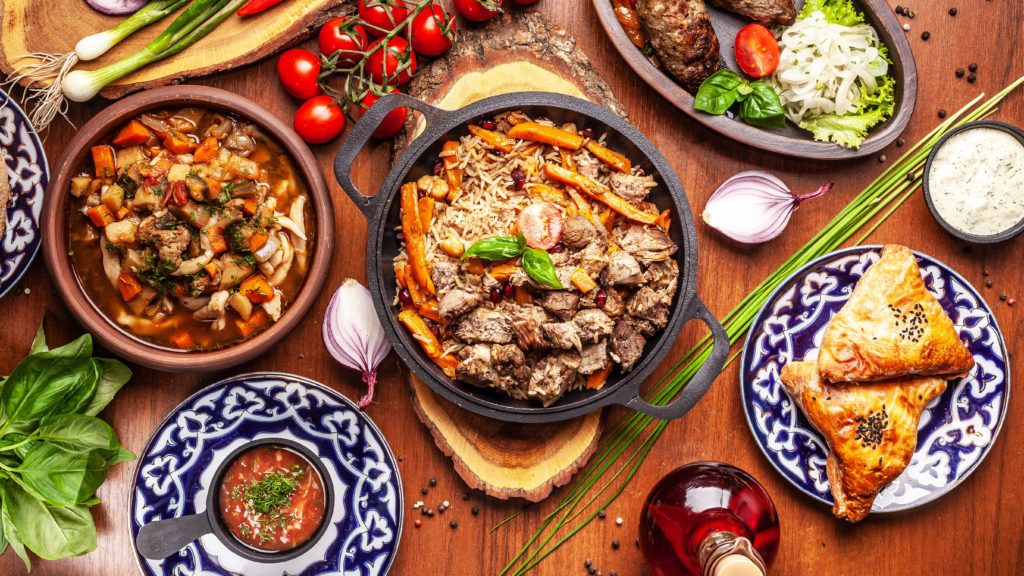
There is a lot of overlap in the cuisines of the three countries. For example, all have some form of dumplings, and they all claim dolmas as an important part of the platter. And, most importantly – the food is VERY filling.
There is a lot of regional variation too, as well as dishes that are most emblematic to just one of the countries.
Vegetarians will get by OK, at least in Tbilisi. Vegans, though… The Caucasus is not well-known for many vegetable-based dishes. If you can’t eat meat, usually the replacement offered is bread with cheese.
Must-Try Dishes in the Caucasus
- Khachapuri (Georgia) – A bread boat filled with lots of cheese and – in the acharuli variation – topped with an egg
- Khinkali (Georgia) – Dumpling filled with broth and usually mince meat
- Lobiani (Georgia) – Bread filled with beans
- Dolma (everywhere) – Minced meat and rice wrapped in a vine leaf
- Lahmacun (Armenia) – “Armenian pizza”. It’s thin-crusted and topped with minced beef, onions, and crushed tomatoes
- Khorovats (Armenia) – Grilled meat kebab
- Kebab/Shashlik (Azerbaijan) – Skewered meats sometimes offered in pita bread
- Plov (Azerbaijan) – An unmissable classic! Saffron-infused rice cooked with herbs, meat, and vegetables
- Piti (Azerbaijan, specifically Sheki) – Lamb stew cooked in a clay pot with vegetables
- Fisinjan (Azerbaijan) – Chicken with chestnuts and pomegranate seeds baked in a clay dish. (My fav Azeri dish!)

Our GREATEST Travel Secrets…
Pop your email here & get the original Broke Backpacker Bible for FREE.
Final Advice Before Visiting Caucasus
Phew. That was a long tour of the Caucasus. Are you feeling out of breath? Cause I am.
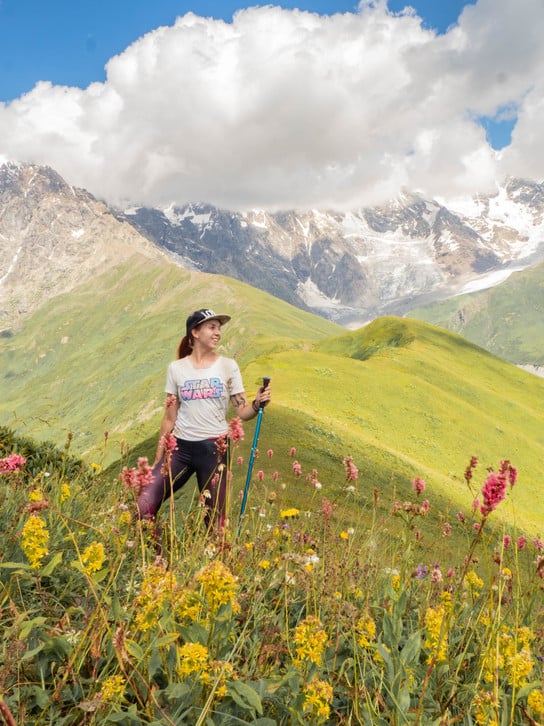
Maybe that’s just because the Caucasus is a breathtaking travel experience. It serves some of the most gorgeous landscapes I’ve ever seen, and definitely my favourite wine.
I LOVE the Caucasus. And this is despite the fact that the entire region seemed to want to kick my ass.
From creepy guys and terrible dates in Baku, to losing my wallet and breaking my phone twice (and my heart – lolz) in Georgia, and having to hide in a cave from a massive thunderstorm in Armenia… I fell in love, head over heels. I can’t wait to visit again.
It would be easy to just bundle all three countries up into one and call it a day. While there is a lot that connects the trinity, they are all their own, distinctive personalities, with their own quirks and secret histories.
Georgia is the most prosperous and enjoying its surge of tourists. Tbilisi is not just some obscure town but soon comparable to big bois on the European backpacking trail like Prague and Budapest.
Armenia is a beautiful country coloured by its tragic past and present. As the conflict with Azerbaijan continues over Nagorno-Karabakh, they are still struggling to get the rest of the world to recognise the genocide that happened a century ago.
And Azerbaijan continues to get richer with oil money, while its farmers and artisans keep living their traditional lives in tiny mountain towns.
The Caucasus is an utterly fascinating, heart-achingly beautiful, immensely interesting destination for all adventurous backpackers. It feels like a very badly kept secret that I still kinda want to keep to myself. But, whenever anyone asks, I can’t stop singing praise to it.
Go to the Caucasus. You won’t regret it.
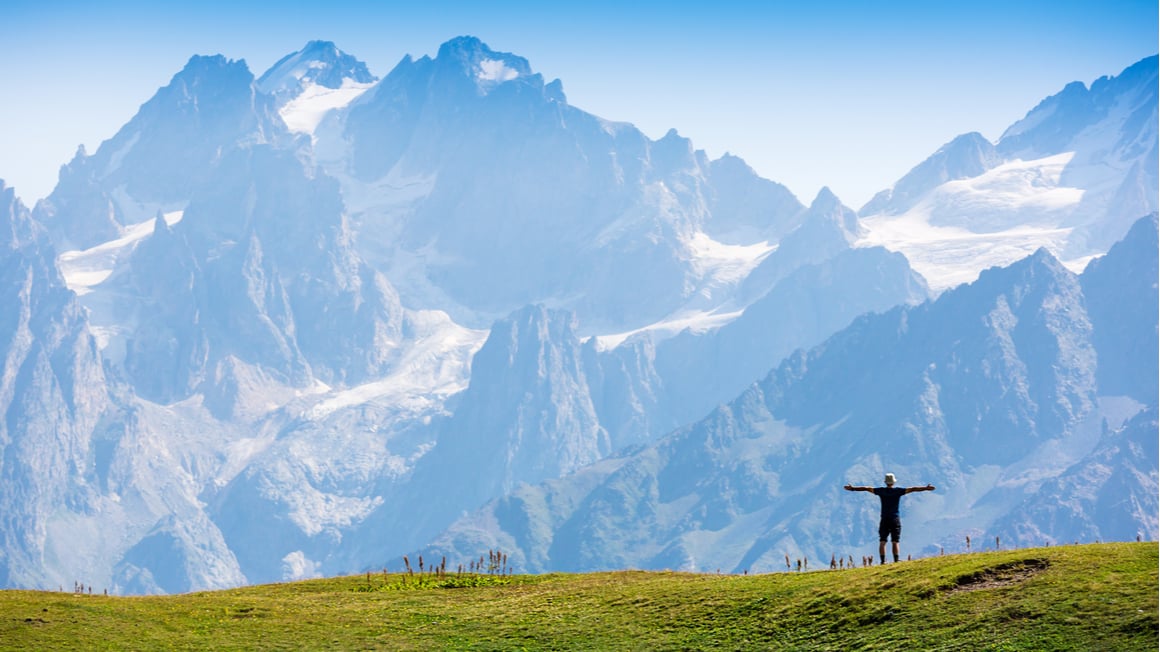

And for transparency’s sake, please know that some of the links in our content are affiliate links. That means that if you book your accommodation, buy your gear, or sort your insurance through our link, we earn a small commission (at no extra cost to you). That said, we only link to the gear we trust and never recommend services we don’t believe are up to scratch. Again, thank you!


